Key Indicators for Asia and the Pacific 2025This report gives statistics on economic, financial, social, environmental measures, and select indicators for the Sustainable Development Goals (SDGs). Statistics for Development Bank's members, including South Asian countries, cover figures for energy, transport and communications, and international trade and logistics. Author: Asian Development Bank Year: 2025 Download Tags: ADB, South Asia, Sustainable Development Goals, Transport, Energy Transition Readiness Assessment for Developing Asia and the PacificThis publication analyzes the unique conditions of developing Asia and the Pacific and presents what the countries need to transition to renewable energy. In South Asia Subregional Economic Cooperation and Central Asia Regional Economic Cooperation countries, power systems are being integrated to improve grid stability and let areas with high renewable resources to transmit electricity to areas with high demand. Author: Asian Development Bank Year: 2025 Download Tags: ADB, Energy, SASEC, CAREC Asian Economic Integration Report 2025This report breaks down how regional integration has affected trade, global value chains, foreign direct investment, and tourism and driven growth in Asia and the Pacific in the last two decades. It looks at how subregions have grown more integrated through such initiatives as the South Asia Subregional Economic Cooperation (SASEC) and the Central Asia Regional Economic Cooperation program. As of June 2024, SASEC projects have totaled $20.8 billion in worth, including $12.8 billion funded by the Asian Development Bank; while 155 technical assistance projects (worth $224.78 million) have supported project preparation, strategic planning, and capacity building. Author: Asian Development Bank Year: 2025 Download Tags: ADB, SASEC, Global Value Chains, CAREC Basic Statistics 2025The 2025 edition of Basic Statistics presents data that help track progress toward the Sustainable Development Goals. This edition lays out data for 46 countries in Asia and the Pacific, including those for the seven South Asia Subregional Economic Cooperation countries. Author: Asian Development Bank Year: 2025 Download Tags: South Asia, Sustainable Development Goals, ADB ADB Annual Report 2024The Asian Development Bank (ADB) Annual Report 2024 details operational and financial results. ADB supported regional cooperation initiatives in South Asia. For instance, ADB committed $662 million to support Nepal’s growing domestic electricity demand and green electricity export aspirations through the South Asia Subregional Economic Cooperation (SASEC) Electricity Transmission and Distribution Strengthening Project. ADB also supported SASEC through health and trade facilitation projects in Bangladesh and India and technical assistance for health and transport in Bhutan and Nepal. Author: Asian Development Bank Year: 2025 Download Tags: ADB, Health, Energy, SASEC, South Asia, Trade Facilitation, Transport 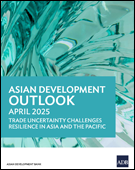 Asian Development Outlook (ADO) April 2025South Asia underwent a slowdown, amid delays in public investment in India. South Asia's gross domestic product (GDP) is estimated at 6.0% in fiscal year (FY) 2025 and 6.2% in FY2026. Bangladesh's GDP growth is estimated at 3.9% in FY2025, amid a projected improvement in manufacturing. In Bhutan, growth in 2025 will rise to 8.5% behind expansion in industry and hydroelectric production. India's GDP will reach 6.7% in FY2025 amid a strong outlook for services and manufacturing. In Maldives, growth will moderate to 5.0% in FY2025 amid slowdowns in construction. GDP growth in Nepal in FY2025 will be at 4.4% with expansion expected in agriculture. Sri Lanka's GDP will moderate to 3.9% in FY2025, though infrastructure investments are forecast to spur growth. In Southeast Asia, Myanmar will experience modest GDP growth of 1.1% in 2025, premised on growth in industry and services.
Author: Asian Development Bank Year: 2025 Download Tags: ADB, Bangladesh, Bhutan, India, Maldives, Myanmar, Nepal, Sri Lanka, Manufacturing, Agriculture, Services Macroeconomic Update: Nepal (September 2024)This issue of Macroeconomic Update: Nepal looks at the challenges that Nepal faces in terms of meeting the Sustainable Development Goals, graduating from the least developed country category, and becoming a middle-income country. The report suggests that, to achieve upper middle-income country status by 2043, Nepal will need a robust strategy for efficient capital mobilization and sustainable growth. Author: Asian Development Bank Year: 2024 Download Tags: Nepal, Export, Sustainable Development Goals, ADB  Powering Nepal: 5 Decades of ADB–Nepal Partnership in the Energy SectorAmong the projects transforming Nepal's energy sector in terms of energy sufficiency and regional cooperation is the SASEC Power System Expansion Project, which is the largest energy project implemented by ADB in Nepal. The project will construct transmission lines that could evacuate up to 2 gigawatts (GW) of electricity from the Kali Gandaki and Marsyangdi river basins. It will also develop infrastructure to facilitate exports of at least 1.2 GW of power to India and scale up on- and off-grid renewable energy supply in Nepal. Another project, the SASEC Power Transmission and Distribution System Strengthening Project, will strengthen transmission substations to support electricity exports and upgrade medium-voltage and low-voltage distribution networks to provide quality and reliable electricity supply to 850,000 new and existing customers in Madhesh Province. Author: Asian Development Bank Year: 2024 Download Tags: Renewable Energy, Nepal, ADB, SASEC, India Asian Economic Integration Report 2024This report looks at how economic factors affect the movement of goods, people, and services across borders. As regional economies work to improve economic cooperation, initiatives such as the South Asia Subregional Economic Cooperation (SASEC) strive to improve cross-border trade and connectivity through such projects as the SASEC Chittagong–Cox’s Bazar Railway Project in Bangladesh and the SASEC Highway Enhancement Project in Nepal, and the Visakhapatnam–Chennai Industrial Corridor Development Program in India. Author: Asian Development Bank Year: 2024 Download Tags: SASEC, Transport, Economic Corridor Development, Bangladesh, India, ADB 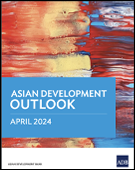 Asian Development Outlook (ADO) April 2024Robust growth is forecast for South Asia in fiscal year (FY) 2024, driven by strong gains in investments, consumption, and the electronics and services sectors. Gross domestic product (GDP) is estimated at 6.3% in FY2024 and 6.6% in FY2025 in South Asia. In Bangladesh, GDP growth is projected at 6.1% in FY2024 behind the growth of traditional low-end garments. Bhutan's projected GDP is at 4.4% given major developments in the country's hydropower sector. In India, GDP is forecast at 7.0% in FY2024, after a strong momentum in manufacturing and services in FY2023 and with exports expected to pick up in FY2025 with the rise in global growth. Growth in Maldives is estimated at 5.4% in FY2024 supported by tourism and construction. Nepal is estimated to grow at 3.6% backed by hydroelectric production and domestic demand. Amid recovery efforts in Sri Lanka, modest growth at 1.9% is forecast for the country in FY2024. In Southeast Asia, Myanmar’s GDP is projected to remain low at 1.2%. Author: Asian Development Bank Year: 2024 Download Tags: South Asia, ADB, Hydropower, Tourism, Bangladesh, Bhutan, India, Maldives, Myanmar, Nepal, Sri Lanka Financing Transport Connectivity in the BIMSTEC RegionFinancing Transport Connectivity in the BIMSTEC Region looks at how to finance an overhaul of transport infrastructure in the Bay of Bengal Initiative for Multi-Sectoral Technical and Economic Cooperation (BIMSTEC) subregion. The report identifies institutional gaps in the BiMSTEC regional institutions compared with regional institutions in the European Commission, Association of Southeast Asian Nations, and the South Asia Subregional Economic Cooperation (SASEC) partnership. Author: Asian Development Bank Year: 2023 Download Tags: ADB, South Asia, Transport, Regional Cooperation Open for Business: How Maldives Overcame the COVID-19 CrisisThe economy of Maldives, being reliant on tourism, went into recession due to border closures and travel restrictions during the coronavirus (COVID-19) pandemic. The pandemic called attention to the need for Maldives to diversify its economy to reduce short-term macroeconomic volatility. In addition, Maldives stands to benefit from setting up regional maritime connectivity for strengthening food trade with other South Asian countries. Author: Abdulla Ali, Elisabetta Gentile, Macrina Mallari, Thiam Hee Ng Year: 2023 Download Tags: ADB, Tourism, COVID-19, Maldives ADB Annual Report 2022In 2022, under the operational priority of Fostering Regional Cooperation and Integration, the Asian Development Bank (ADB) provided support for a $143-million program in Bangladesh to construct integrated customs stations and land ports at border-crossings to help increase trade volumes among South Asia Subregional Economic Cooperation (SASEC) countries. In India, ADB committed $300 million to upgrade district roads in Assam, which will reduce travel time to SASEC corridors. ADB is also supporting a nonsovereign loan that would improve communication network capacity and mobile services in Maldives. Author: Asian Development Bank Year: 2023 Download Tags: ADB, SASEC, Maldives, India, Bangladesh, Road 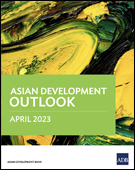 Asian Development Outlook (ADO) April 2023South Asia is projected to grow faster than other subregions in Asia, with real gross domestic product (GDP) estimated at 5.5% in fiscal year (FY) 2023 and 6.1 in FY2024. Growth within South Asia is expected to vary, with India projected to grow by 6.4% in FY2023 and 6.7% in FY2024 behind strong domestic demand. In Bangladesh, GDP growth is estimated at 5.3% in FY2023 owing to global economic disruptions and 6.5% in FY2024. In Bhutan, hydropower production will push up growth to 4.6% in FY2023 and 4.2% in FY2024. Growth in Maldives is estimated at 7.1% in FY2023 and 6.9% in FY2024, supported by a boom in tourism and construction. In Nepal, growth will slow to 4.1% this year before picking up in FY2024 at 5.0% with a recovery in tourism and infrastructure. Sri Lanka is projected to contract at -3.0% in FY2023 before recovering to 1.3% in FY2024 premised on debt relief and key reforms. In Southeast Asia, Myanmar's GDP will rise moderately to 2.8% in FY2023 and 3.2% in FY2024. Author: Asian Development Bank Year: 2023 Download Tags: South Asia, Hydropower, ADB, Bangladesh, Bhutan, India, Maldives, Myanmar, Nepal, Sri Lanka Asian Economic Integration Report 2023This report shows how smart trade and investment policies, and regulatory cooperation in the Asia and Pacific region can help economies tackle climate change, recover from the pandemic, and support resilient and sustainable development. Analyzing topics including global value chains, investment, the movement of people, and regional cooperation initiatives, it outlines the economic and environmental challenges the region currently faces. It explores how trade and investment policies can support climate action and highlights why a joined-up approach is essential to help deepen the digital economy, strengthen supply chains and foster greener businesses, markets, and trade. Author: Asian Development Bank Year: 2023 Download Tags: SASEC, Infrastructure, ADB, Connectivity, Climate Change, Global Value Chains, Trade Asian Development Outlook (ADO) 2022 Supplement: Global Gloom Dims Asian ProspectsSouth Asia is projected to grow at 6.5% in fiscal year (FY) 2022 and 6.3% in FY2023. In Bangladesh, weak exports and high inflation are hampering recovery, while in Bhutan, agriculture and construction are projected to support economic growth. In India, growth is projected at 7.0% in FY2022 and 7.2% in FY2023, sustained by public reform and public and private investment. Maldives tourist arrivals and construction continue to pick up. In Nepal, the 2023 budget aims to improve agriculture, industry, and social protection. Economic contraction is expected in Sri Lanka with marked declines in industry and agriculture. In Southeast Asia, Myanmar maintains positive growth projections despite high rates of inflation. Author: Asian Development Bank Year: 2022 Download Tags: ADB, Agriculture, South Asia, Southeast Asia, Investment, Social Protection Key Indicators for Asia and the Pacific 2022Key Indicators for Asia and the Pacific 2022 provides statistics on economic, financial, social, and environmental measures, as well as select indicators for the Sustainable Development Goals (SDGs). Statistics for Asian Development Bank's member countries include numbers for energy and electricity, transport and communications, and international trade. Author: Asian Development Bank Year: 2022 Download Tags: ADB, South Asia, Sustainable Development Goals  Asian Development Outlook (ADO) 2022 Update: Entrepreneurship in the Digital AgeGrowth forecast in South Asia is projected at 6.5% in fiscal year (FY) 2022 and FY2023. In Bangladesh, gross domestic product (GDP) growth is projected at 7.2% in FY2022 and 6.6% in FY2023, reflecting lower consumption spending. Growth in Bhutan is forecast to grow at 4.5% in FY2022 and 4.0% in FY2023 as government investment continues as a key driver of growth. In India, weaker than expected global demand is expected to affect growth, projected at 7.0% for FY2022 and 7.2% for FY2023. GDP growth in Maldives is forecast at 8.2% in FY2022 and 10.4% in FY2023 with continued tourism arrivals. In Nepal, GDP is projected at 5.8% in FY2022 and 4.7% in FY2023, affected in part by needed policy tightening to address rapid rise in imports. Contractions are projected for Sri Lanka, -8.8% in FY2022 and -3.3% in FY2023, likely resulting from severe macroeconomic challenges, including the impact of the ongoing crisis. In Southeast Asia, Myanmar's GDP is forecast at 2.0% in FY2022 and 2.6% in FY2023 owing to an improvement in economic activity. Author: Asian Development Bank Year: 2022 Download Tags: ADB, Bangladesh, Bhutan, India, Maldives, Myanmar, Nepal National Single Window: Guidance NoteElectronic national single window systems help stakeholders meet trade and transit requirements. Single windows allow trade and transit sectors to send information to multiple agencies through one platform, thereby helping reduce processing time and the cost of doing business. This guidance note compiles information on planning and implementing national single window systems that help countries comply with international trade regulations. Author: Asian Development Bank Year: 2022 Download Tags: ADB, National Single Window, Trade, Transport 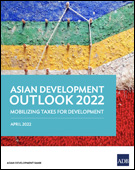 Asian Development Outlook (ADO) 2022: Mobilizing Taxes for DevelopmentGrowth in South Asia is projected to remain strong at 7.0% in FY2022 and 7.4% in FY2023 as the region’s economies try to catch up to pre-pandemic levels. In Bangladesh gross domestic product (GDP) growth is projected at 6.9% in FY2022. Growth in FY2023, projected at 7.1%, will be driven by private consumption. Bhutan is forecast to grow at 4.5% in FY2022. Growth will accelerate to 7.5% in FY2023 with the reopening of international tourism in the country. India is forecast to grow at 7.5% in FY2022 and 8.0% in FY2023, buoyed by strong investment growth. GDP growth in Maldives is forecast at 11.0% in FY2022 and 12.0% in FY2023 with continued tourism arrivals. In Nepal, fiscal stimulus and wider vaccination coverage will support growth, projected at 3.9% in FY2022 and 5.0% in FY2023. Sri Lanka's growth is forecast to slow to 2.4% in FY2022 and pick up to 2.5% in FY2023 amid low foreign exchange reserves. In Southeast Asia, Myanmar’s economy is forecast to contract in FY 2022 on protracted political instability. Myanmar GDP is forecast at -0.3% in FY2022 and 2.6% in FY2023. Author: Asian Development Bank Year: 2022 Download Tags: ADB, Bangladesh, Bhutan, India, Nepal, Sri Lanka, Maldives, Myanmar Regional Cooperation and Integration in Asia and the Pacific: Responding to the COVID-19 Pandemic and "Building Back Better"Platforms for regional and subregional cooperation helped spur collective action to help Asia and the Pacific build back resiliency from the coronavirus disease (COVID-19) pandemic. Regional cooperation platforms such as the South Asia Subregional Economic Cooperation program helped countries respond to the COVID-19 emergency. In South Asia, partners will have the opportunities to support regional market development through transport corridors, trade facilitation, and cross-border energy trade post-COVID-19. Author: Asian Development Bank Year: 2022 Download Tags: ADB, Bangladesh, COVID-19, Economic Corridor Development, Energy, India, Trade Facilitation, SASEC, ADB RCI 2022 , ADB RCI Asian Economic Integration Report 2022: Advancing Digital Services Trade in Asia and the PacificAs of December 2021, 73 South Asia Subregional Economic Cooperation (SASEC) projects worth $17.43 billion had been financed. The SASEC Program was able to sustain its momentum in 2020 and 2021 in spite of setbacks brought about by the coronavirus pandemic. In 2020–2021, the Asian Development Bank (ADB) committed $2.36 billion for 13 regional cooperation and integration projects in the subregion, including five transport projects, three energy projects, and five multisector/economic corridor projects. The SASEC Secretariat is reviewing the progress of the SASEC Vision initiatives to help make coordination mechanisms more effective and to improve resource mobilization. Author: Asian Development Bank Year: 2022 Download Tags: Trade, SASEC, ADB, COVID-19, Regional Cooperation Asian Development Outlook (ADO) 2021 Supplement: Recovery ContinuesSouth Asia’s economic growth is projected at 8.6% for fiscal year
(FY) 2021, while the forecast for FY2022 stands at 7.0%. In Bangladesh,
exports and imports grew due to rising global demand in clothes. In India,
gross domestic product (GDP) growth remained strong, driven by growth
in private consumption and investments. Maldives saw an increase of 193.3%
in tourist arrivals from January to October in 2021 compared with
2020. In Nepal, GDP grew by 2.5% in FY2021 due to a rebound in
services. In Sri Lanka, GDP grew by 12.3% in the second quarter of
2021, with growth prospects for 2022 downgraded due to macroeconomic
challenges. Previously, in the Asian
Development
Outlook Update, the GDP of Bhutan and Myanmar were forecast to
contract in FY2021. Author: Asian Development Bank Year: 2021 Download Tags: South Asia, Export, ADB, Import Reforming Port Processes in India for Logistics EfficiencyResearchers undertook port-process mapping at Jawaharlal Nehru and Vishakhapatnam ports, two key export–import gateways in India, to help identify strategic reform and potential solutions to improve port systems in the country. This brief recommends streamlining and digitizing port logistics and operations in India to help reduce logistics cost and make operations more efficient. Author: Asian Development Bank Year: 2021 Download Tags: ADB, India, Customs, ADB RCI Key Indicators for Asia and the Pacific 2021Key Indicators for Asia and the Pacific 2021 provides updated statistics on economic, financial, social, and environmental measures as, well as select indicators for the Sustainable Development Goals (SDGs). Statistics are for 49 regional members of the Asian Development Bank, including numbers for energy and electricity, transport and communications, and international trade. Author: Asian Development Bank Year: 2021 Download Tags: ADB, South Asia, Sustainable Development Goals Asian Development Outlook 2021 UpdateEconomic growth in South Asia is projected at 8.8% in 2021 while the outlook for next year has been raised to 7.0% from 6.6%. In Bangladesh, growth in fiscal year (FY) 2022 is projected to strengthen though still below pre-coronavirus pandemic levels. In Bhutan, gross domestic product (GDP) in FY2021 is estimated to have contracted by 3.4%; growth is forecast to rebound to 3.7% in FY2022. The projection for India is downgraded to 10.0% from the earlier projection of 11.0% in FY2021, while the outlook for FY2022 improved to 7.5% from 7.0%. Tourist arrivals in Maldives increased by 33.4% year on year in 2021. In Nepal, GDP growth is estimated at 2.3% in FY2021. In Sri Lanka, GDP growth forecasts are revised down to 3.4% in 2021 with risks from fresh pandemic outbreak and currency related stress. Author: Asian Development Bank Year: 2021 Download Tags: ADB, COVID-19, South Asia, Bangladesh, Bhutan, India, Maldives, Sri Lanka Quarterly Dossier: Catalytic Multi-modal Connectivity Initiatives in the BBIN Sub-regionVarious national, bilateral, trilateral, and subregional initiatives in multimodal connectivity in the Bangladesh-Bhutan-India-Nepal (BBIN) subregion support faster and safer trade and transport. These have multiple positive impacts, including those that improve delivery of services to deal with the coronavirus pandemic. This publication presents four stories that show the impact of infrastructure connectivity in BBIN countries. It provides an assessment of connectivity initiatives as well as suggestions to enhance the positive effects of these initiatives. Author: CUTS International Year: 2021 Download Tags: ADB, BBIN, COVID-19, Trade, Transport Asian Economic Integration Report 2021: Making Digital Platforms Work for Asia and the PacificThis report reviews economic cooperation and integration in Asia and the Pacific. As of the end of 2019, ADB had committed a total of $13.77 billion to 60 projects under the South Asia Subregional Economic Cooperation (SASEC) partnership, including projects for improving transport connectivity, trade facilitation, and power transmission. In 2019, SASEC members revamped the SASEC Operational Plan 2016–2025 to prioritize narrowing gaps in the subregion’s transport and energy networks. The SASEC program focused on expanding multimodal connectivity to include maritime and inland water transport. Subregional health cooperation was strengthened in 2020 to improve access to health services in Asia and the Pacific. Author: Asian Development Bank Year: 2021 Download Tags: ADB, Regional Cooperation, SASEC, Transport, Trade Facilitation, Energy COVID-19 and Transport in Asia and the Pacific: Guidance NoteThis guidance note outlines the effects of the coronavirus disease pandemic on the transport sector in developing Asia and the Pacific. In India, for example, rail freight traffic in April and May 2020 had decreased by 28% compared with demand in 2019. The publication shares possible measure for a post-pandemic recovery that provides greener and more resilient recovery. The publication also proposes regional cooperation bodies for coordinating cross-border freight and logistics and international air travel. Author: Asian Development Bank Year: 2020 Download Tags: ADB, Regional Cooperation, India, Transport, Logistics, ADB RCI Energy Insecurity in Asia: Challenges, Solutions, and Renewable EnergyThis book explores challenges in addressing energy insecurity in Asia. Bhutan, Myanmar, Nepal, and other energy surplus countries could export electricity and get huge economic gains, while Bangladesh, India, Sri Lanka, and other energy-deficient countries could grow faster by importing energy. Cross-border renewable energy projects could also reduce dependence on coal and oil and thus limit environmental damage. Author: Naoyuki Yoshino, Farhad Taghizadeh-Hesary, Youngho Chang, and Thai-Ha Le (editors) Year: 2020 Download Tags: ADB, Regional Cooperation, Renewable Energy New Approaches to Measuring and Assessing Regional Cooperation and Integration: Workshop HighlightsThis publication presents highlights from the Asian Development Bank (ADB) workshop on regional cooperation and integration on 16 and 17 April 2020. Discussions focused on approaches to measuring RCI and its implications for policy assessment. Mr. Ronald Antonio Butiong, Director, Regional Cooperation and Operations Coordination Division, South Asia Department, ADB, discussed regional integration indicators in South Asia Subregional Economic Cooperation (SASEC) member countries and outlined priorities for enhancing economic growth, improving social inclusion, and tackling poverty. Author: Asian Development Bank Year: 2020 Download Tags: Regional Cooperation, South Asia, SASEC, ADB, ADB RCI Summary of Proceedings of the 53rd ADB Annual Meeting of the Board of GovernorsThe Fifty-Third Annual Meeting of the Board of Governors of the Asian Development Bank (ADB) was held virtually in two stages in May and September 2020. Ms. Nirmala Sitharaman, Minister of Finance, India, called for the establishing of a regular South Asia Subregional Economic Cooperation (SASEC) meeting of finance ministers by 2021 to further strengthen regional cooperation. Mr. Ibrahim Ameer, Finance Minister, Maldives, noted how ADB has assisted Maldives through the SASEC National Single Window Project. Author: Asian Development Bank Year: 2020 Download Tags: SASEC, ADB, India, Maldives, Regional Cooperation, National Single Window Developing Multimodal Logistics Parks in IndiaMultimodal logistics parks (MMLPs) help bring down the cost of logistics and improve logistics performance by providing services in freight aggregation and distribution, multimodal freight transport, integrated storage and warehousing, technology support, and value-added services. This brief from the Asian Development Bank examines the potential of MMLPs to support supply chains in India and discusses the feasibility of MMLPs in Bengaluru and Guwahati. Author: Sabyasachi Mitra, Hoe Yun Jeong, Kavita Iyengar, Bhuwan Bhaskar Agrawal, Shreyans Jain, and Atu Sanganeria Year: 2020 Download Tags: ADB, Bangladesh, India, Logistics, ADB RCI Enhancing Productivity for Poverty Reduction in India This brief looks at labor productivity in India and its impact on poverty reduction. It notes the need to bridge the infrastructure gap, improve the investment climate, and invest in education. Economic corridors would boost inclusive development, as these would act as markets for goods, help overcome infrastructure and regulatory bottlenecks, and aid dynamic reallocation. One such corridor is the Vizag–Chennai Industrial Corridor, which the Asian Development Bank is supporting with a $631 million loan. Author: Kanupriya Gupta and Abhijit Sen Gupta Year: 2020 Download Tags: ADB, India, Economic Corridor Development Review of the ADB Clean Energy ProgramThis publication presents a review of the Clean Energy Program of the Asian Development Bank (ADB). It looks at what needs to be done in light of goals of mitigating climate change and promoting sustainable development. It also looks at the goals in terms of ADB’s Strategy 2030. Fostering regional cooperation and integration is among the operational priorities ADB has identified in Strategy 2030. ADB operations in the energy sector has promoted energy connectivity—such as through power interconnections in South Asia—and sharing best practices and technologies in renewable energy development. Author: Asian Development Bank Year: 2020 Download Tags: ADB, Energy, South Asia, Renewable Energy Asia's Journey to Prosperity: Policy, Market, and Technology Over 50 YearsThis book presents factors that can explain Asia's development performance. It looks at the role of policy, market, and technology in promoting trade and investment, infrastructure, and regional cooperation and integration (RCI). In South Asia, RCI has focused on connectivity through transport, energy, and trade facilitation. The Asian Development Bank has supported RCI by initiating several subregional programs, such as the Greater Mekong Subregion (GMS), the Central Asia Regional Economic Cooperation (CAREC), and the South Asia Subregional Economic Cooperation (SASEC). Author: Asian Development Bank Year: 2020 Download Tags: ADB, SASEC, Regional Cooperation, Trade, Energy ADB Annual Report 2019The Asian Development Bank (ADB) 2019 Annual Report details ADB’s operations, activities, and financial results over the year. ADB helps foster regional cooperation and integration through its support of the SASEC Program. In 2019, ADB committed $495 million to reduce travel times along regional corridors connecting Nepal with India and Bangladesh and improve connections to Sri Lanka’s international port under the SASEC Program. Author: Asian Development Bank Year: 2020 Download Tags: ADB, SASEC, South Asia, Regional Cooperation Asian Development Outlook (ADO) 2020: What Drives Innovation in Asia?Growth in developing Asia is forecast to slow to 2.2% in fiscal year (FY) 2020 due to the effects of the global health emergency. In South Asia, growth will decelerate to 4.1% in FY2020 and rebound to 6.0% in FY2021 following a projected revival in India. Bangladesh is projected to grow by 7.8% this fiscal year and 8.0% in FY2021. GDP growth in Bhutan, despite lower tourist arrivals, will accelerate on high government spending. Growth in Maldives and Sri Lanka will be constrained this year due to weaker tourism. In Nepal, the outlook is for moderating growth. In Southeast Asia, Myanmar growth is expected to slow in FY2020 and pick up in FY2021. Author: Asian Development Bank Year: 2020 Download Tags: ADB, Bangladesh, Bhutan, India, Maldives, Myanmar, Nepal, Sri Lanka, Tourism, FDI Accelerating Regional Cooperation and Integration in Asia and the Pacific: 2017 Conference HighlightsRegional cooperation and integration (RCI) plays a critical role in accelerating economic growth, reducing poverty and economic disparity, and raising productivity and employment. This conference report looks at challenges for accelerating RCI in Asia and the Pacific, with a focus on economic corridors and emerging RCI initiatives. It underscores the importance of gateway ports to multimodal transport, such as the Port of Chittagong in Bangladesh under the South Asia Subregional Economic Cooperation (SASEC) program. The report also maintains that RCI technical secretariats, such as that for the SASEC partnership, are vital to fostering RCI across Asia and the Pacific. Author: Asian Development Bank Year: 2019 Download Tags: ADB, Economic Corridor Development, Regional Cooperation, Trade, Transport, SASEC Infrastructure Financing in AsiaThis book discusses how private financing can help address Asia’s infrastructure investment needs. In South Asia, public spending and public-private partnerships (PPP) may be leveraged for large infrastructure needs. Challenges that arise from each source of infrastructure financing—such as the long-term nature of PPP contracts—need to be addressed. Author: Asian Development Bank Year: 2019 Download Tags: ADB, South Asia Asian Development Outlook (ADO) 2019 Supplement, December: Growth Slows Further in Developing Asia’s GiantsDeveloping Asia's gross domestic product is projected to grow by 5.2% both in 2019 and 2020 as a slowing of global economic activity tempers regional growth, according to the Asian Development Outlook (ADO) 2019 Supplement. In South Asia, growth forecasts have been lowered to 6.1% in 2020. Strong remittances in Bangladesh will raise domestic demand, while in Bhutan, hydropower production rose to 3.1% in Q1 of FY2020 (ending 30 June 2020). Growth in India is expected to recover to 6.5% in 2020 with government policy measures, such as a corporate tax cutt and policy rate reduction. In Maldives, tourism remains strong. Foreign direct investments surged in Nepal while a recovery in economic activity is projected in Sri Lanka. Author: Asian Development Bank Year: 2019 Download Tags: ADB, South Asia, Hydropower, Tourism, Investment, Bangladesh, Bhutan, Maldives, Nepal, Sri Lanka 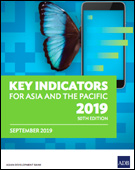 Key Indicators for Asia and the Pacific 2019This report presents the latest economic, financial, social, and environmental statistics, and includes sustainable development goals indicators, for the 49 regional members of the Asian Development Bank (ADB). Remittances have been a stable source of revenue for Asia and the Pacific, with India being the top recipient of remittances globally at $78.6 billion in 2018. In 2017, foreign direct investment (FDI) in the region rose to $541.9 billion, although FDI flows have been more volatile compared to remittance flows. This report uses domestic value-added via forward linkages (DVA_F) to discuss the evolution of global value chains in Asia. In 2018, almost a third of the DVA_F generated in Asia stayed within the region, representing 39.0% of the total domestic value-added sent to the region. It shows the importance of intraregional trade for Asia, as Asia's trade connection to North America is weakening. Author: Asian Development Bank Year: 2019 Download Tags: ADB, India, South Asia, Sustainable Development Goals, Trade Borders without Barriers: Facilitating Trade in SASEC CountriesBorders without Barriers presents an analysis of the state of trade facilitation in member countries of the South Asia Subregional Economic Cooperation (SASEC) program. The book includes an analysis of the state of trade facilitation in Bangladesh, Bhutan, India, Nepal, and Sri Lanka, as well as in Maldives and Myanmar. It identifies trade facilitation priorities in SASEC countries: implementation of trade facilitation agreements and other conventions; logistics and infrastructure development and regulatory reforms; coordinated border management; and institutions and capacity development. Author: Asian Development Bank Year: 2019 Download Tags: ADB, SASEC, Trade Facilitation Agreement, Bangladesh, Bhutan, India, Maldives, Myanmar, Nepal, Sri Lanka, ADB RCI 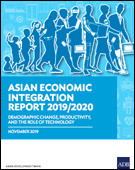 Asian Economic Integration Report 2019/2020: Demographic Change, Productivity, and the Role of TechnologyThis report reviews economic cooperation and integration in Asia and the Pacific. It reports that in 2018, the South Asia Subregional Economic Cooperation (SASEC) focused on reducing gaps in multimodal connectivity among its member countries. By the end of 2018, 52 ADB-financed projects worth $11.36 billion had been committed to SASEC projects, with an additional $106.44 million in 81 technical assistance grants. SASEC nodal officials and working groups met in Singapore in March 2018 to update the SASEC operational plan. The operational plan identified 77 projects ($45.6 billion) to be financed by SASEC members, ADB, and development partners. A holistic approach under the operational plan will build transport links with Southeast Asia and East Asia and expand regional trade markets. Author: Asian Development Bank Year: 2019 Download Tags: ADB, Regional Cooperation, SASEC, Trade Facilitation, Transport, Bangladesh, Bhutan, India, Maldives, Myanmar, Nepal, Sri Lanka Asian Development Outlook (ADO) 2019 Update: Fostering Growth and Inclusion in Asia's CitiesGrowth in developing Asia remains strong despite the slowing down of international trade and a weakening of investments. In South Asia, growth momentum has slowed, with growth forecasts lowered to 6.2% for 2019 and retained at 6.7% for 2020. Growth in India has softened but is expected to bounce back to 7.2% in 2020. Bangladesh and Nepal performed better than projected. Bhutan’s growth slowed to 5.3% in fiscal year (FY) 2019 due to a decline in hydroelectric generation. Growth projection for FY2020 is retained at 6.0%. In Sri Lanka, growth forecast has been lowered for 2019 and 2020. Forecasts for Maldives is retained as tourist arrivals increased in the first half of 2019. In Southeast Asia, growth projections for Myanmar has been retained. Author: Asian Development Bank Year: 2019 Download Tags: Hydropower, ADB, Bangladesh, Bhutan, India, Maldives, Myanmar, Nepal, Sri Lanka 2018 Development Effectiveness ReviewThis report looks at the Asian Development Bank’s (ADB) performance in achieving the goals set out in ADB’s Strategy 2020. In its South Asia operations, ADB supported the linking of countries through transport connectivity. ADB has committed $180 million to rehabilitate the Kanchanpur–Kamala section of the East–West Highway in Nepal to promote safety and transport connectivity. It is also committed to a $150 million project through the South Asia Subregional Economic Cooperation Road Connectivity Investment Program to upgrade a section of the Asian Highway connecting Manipur, India, to Myanmar and construct an international bridge between India and Nepal. Author: Asian Development Bank Year: 2019 Download Tags: ADB, India, Jobs, Myanmar, Nepal, SASEC, Transport, Road ADB Annual Report 2018The Asian Development Bank (ADB) supports cross-border infrastructure to help foster regional cooperation and integration. It is transforming transport corridors into economic corridors, allowing South Asian countries to participate in regional and global value chains and promote agriculture trade. In 2018, ADB committed $150 million to upgrade sections of South Asia Subregional Economic Cooperation (SASEC) road corridors in India and Nepal. The investments aim to improve connectivity between Manipur (in India) and Myanmar; build an India–Nepal international bridge; and improve the safety of Nepal’s East–West Highway. ADB also approved a technical assistance project to build institutional capacity and improve expertise of trade facilitation officials in SASEC member countries. Author: Asian Development Bank Year: 2019 Download Tags: Economic Corridor Development, ADB, Energy, India, Nepal, SASEC, Trade Facilitation Asian Development Outlook (ADO) 2019: Strengthening Disaster ResilienceDeveloping Asia is projected to grow at 5.7% in 2019 and 5.6% in 2020. South Asia is projected to bounce back in 2019 and 2020 from the previous year’s slowdown. India’s growth is expected to pick up to 7.2% in 2019 (from 7.0% in the previous year) on recovery in agriculture and strong domestic demand. Bangladesh is projected to grow by 8.0% in 2019. Bhutan is expecting modest growth while the outlook for Maldives is for growth to moderate. Nepal should expect stable growth in 2019 while Sri Lanka is projected to recover moderately. Inflation in South Asia is projected to rise to 4.7% in 2019. Growth should pick up in Myanmar in Southeast Asia. Author: Asian Development Bank Year: 2019 Download Tags: ADB, South Asia, Bangladesh, Bhutan, India, Myanmar, Maldives, Nepal, Sri Lanka Sustaining Harbor Operation and Maintenance in MaldivesImproved inter-island connectivity plays a key role to achieving inclusive growth in Maldives. This Asian Development Bank brief explores investments in harbor infrastructure, operation, and maintenance in Maldives, and looks to understand the opportunities these provide, especially for women, and for poor and vulnerable groups in the country. Author: Andri Heriawan Year: 2018 Download Tags: ADB, Maldives, Transport Asian Development Outlook 2018 Supplement: The Outlook Firms as Trade Conflict PausesGrowth forecasts for developing Asia stand at 5.8% in 2019. South Asia is still the fastest-growing subregion in developing Asia, while 2019 forecasts are revised down marginally at 7.1%. Bangladesh maintains its growth momentum with the expansion of exports and remittances. Growth in Bhutan has moderated while tourist arrivals grew strongly in Maldives. India exports are increasing along with the country’s industrial and agricultural output. GDP in Sri Lanka grew by 3.7% amid revived private consumption. In Nepal, exports surged by 16.1% while remittances grew to a record $2.1 billion. Author: Asian Development Bank Year: 2018 Download Tags: ADB, Bangladesh, Bhutan, India, Maldives, Nepal, Sri Lanka Investment Climate Improvement in East Coast Economic Corridor of India: Regulatory, Institutional, and Policy Reforms Support to Tamil NaduThis paper summarizes a study that the Asian Development Bank (ADB) undertook upon the request of the Government of Tamil Nadu, India. The state sought to become a preferred investment destination with an investor-friendly business climate. The study identified policy, institutional, and process reforms to improve the ease of doing business in Tamil Nadu, including institutional and regulatory reforms needed for the East Coast Economic Corridor (ECEC) development. The study resulted in the implementation of an online single window mechanism that simplified and sped up processes for transparent and time-bound clearances for investors. Author: Asian Development Bank Year: 2018 Download Tags: ADB, Ease of Doing Business, Economic Corridor Development, India, Single Window, ADB RCI 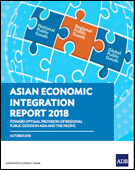 Asian Economic Integration Report 2018This report tracks the progress of regional cooperation and integration in Asia. It shows how intraregional trade grew in South Asia, Southeast Asia, and the Pacific. In South Asia, the South Asia Subregional Economic Cooperation (SASEC) has been focused on building multimodal connectivity to facilitate trade as one of its priorities. Its operational plan is being reviewed to better reflect regional project priorities in the region. SASEC is also studying how Myanmar, its newest member, is to be integrated as a vital link between South Asia, Southeast Asia, and East Asia. The chapter "Toward Optimal Provision of Regional Public Goods in Asia and the Pacific" looks at how collective action among countries can help find solutions for such transnational challenges as infrastructure connectivity, environmental degradation, and transnational health threats. Author: Asian Development Bank Year: 2018 Download Tags: ADB, Regional Cooperation, SASEC, Trade Facilitation Key Indicators for Asia and the Pacific 2018This report presents the latest economic, financial, social, and environmental statistics for the 48 regional members of the Asian Development Bank (ADB). In 2017, foreign direct investment flows to developing Asia was stable, with 8.8% going to South Asia; energy gains were made in five of six countries in South Asia; and starting a business continues become easier in most developing ADB member economies following lowered regulatory costs and simplified compliance procedures. Nepal and Armenia experienced the most rapid annual growth rate at 7.5%, while India witnessed a 6.7% growth in GDP. Author: Asian Development Bank Year: 2018 Download Tags: ADB, Energy, Transport, Bangladesh, Bhutan, India, Maldives, Nepal, Southeast Asia, Sri Lanka Asian Development Outlook (ADO) 2018 Update: Maintaining Stability Amid Heightened UncertaintyThis Update forecasts 6.0% growth for the region in 2018 and 5.8% in 2019. In South Asia, economic outlook remains optimistic. The region is expected to sustain its growth momentum, and meet projections of 7.0% in 2018 and 7.2% in 2019. Forecast for India is maintained at 7.3% in 2018 and 7.6% in 2019. Robust investment climate in Bangladesh is driving projections from 7.0% to 7.9% in 2018 and 7.2% to 7.5% in 2019, and in Nepal, from 4.9% to 5.9% in 2018. A drop in domestic demand lowers growth projections for Bhutan, from 7.1% to 6.7% in 2018 and 7.4% to 7.1% in 2019, and Sri Lanka, from 4.2% to 3.8% in 2018 and 4.8% to 4.5% in 2019. Author: Asian Development Bank Year: 2018 Download Tags: South Asia, India, Bangladesh, Nepal, Sri Lanka, ADB, Bhutan The WEB of Transport Corridors in South AsiaThis book looks at how the economic benefits of investments in transport corridors could be amplified and how negative impacts could be minimized in South Asia. The book introduces an appraisal methodology that looks at the web of interconnected elements around corridors and assesses proposed corridors according to their potential to bring wider economic benefits (WEB). It uses case studies of past and recent corridor initiatives, and presents a simulation of the impact of the proposed Kolkata-Dhaka corridor. Author: Asian Development Bank, JICA, UKAID, World Bank Year: 2018 Download Tags: ADB, Economic Corridor Development, Gender, Regional Integration, Roads, Trade, Transport, WB, ADB RCI Strategy 2030: Achieving a Prosperous, Inclusive, Resilient, and Sustainable Asia and the Pacific Under its new long-term strategy, the Asian Development Bank (ADB) continues its efforts to eradicate extreme poverty while bringing focus to a vision of a prosperous, inclusive, resilient, and sustainable Asia-Pacific. ADB’s key operational priorities include the fostering of regional cooperation and integration, covering its support for enhancing connectivity and competitiveness, promoting regional public goods, and strengthening the financial sector cooperation. ADB also aims to strengthen subregional initiatives, such as the South Asia Subregional Economic Cooperation (SASEC) Program. Author: Asian Development Bank Year: 2018 Download Tags: ADB, Energy, Regional Cooperation, SASEC, Regional Integration, Connectivity Embracing the E-commerce Revolution in Asia and the PacificAsia is the world’s largest e-commerce marketplace. In South Asia, India has the largest e-commerce market at $33 billion in 2017. Maldives, Bhutan, and Sri Lanka lead the subregion in terms of percentage of the population with access to the internet. This report introduces a framework for analyzing the quality of e-commerce development in the Asia-Pacific region and discusses lessons learned regarding e-commerce development. The framework incorporates economic factors, institutional environment, and social acceptance to assess e-commerce development and suggest the way forward. Author: Asian Development Bank, United Nations Economic and Social Commission for Asia and the Pacific Year: 2018 Download Tags: ADB, ICT, Trade, UNESCAP, Maldives, Bhutan, Sri Lanka Asian Development Outlook 2018 Supplement: The Outlook Remains Stable South Asia continues to be the fastest expanding subregion, with growth on track to achieve forecasts of 7.0% in 2018 and 7.2% in 2019. India will meet April forecasts of 7.3% in 2018 and 7.6% in 2019. Owing to strong agricultural growth in Bangladesh and industry growth in Nepal, 2018 GDP growth in the two countries surpassed earlier forecasts. Decline in construction slowed Sri Lanka’s economic growth to 3.2% while hydropower production was lower than forecast in Bhutan. Cement, wood, and metal imports grew in Maldives. Author: Asian Development Bank Year: 2018 Download Tags: ADB, Bangladesh, Bhutan, Energy, Hydropower, India, Maldives, Nepal, Sri Lanka High-Speed Railway, Market Access, and Economic GrowthHigh-speed railway in the People’s Republic of China exerts positive impact effects on growth, where a 1% increase in market access leads to an increase of 0.12% in real income. Drawing insights from the effects of transport infrastructure in India, this paper suggests that high-speed railway could help promote regional cooperation and stimulate regional economic growth. Author: Wei Zou, Liangheng Chen, and Junke Xiong Year: 2018 Download Tags: ADB, Regional Cooperation, Transport, Railway Basic Statistics 2018Basic Statistics presents development indicators for 45 economies in the Asia and Pacific region, including those for the seven SASEC countries, Bangladesh, Bhutan, India, Maldives, Myanmar, Nepal, and Sri Lanka. It presents selected core indicators such as international and national poverty rates, inflation, and current account balance. It also presents information on indicators related to land, population, sustainable development goals, national accounts, money, balance of payments, reserves, external debt, and central government finance. Author: Asian Development Bank Year: 2018 Download Tags: Energy, ADB, Trade, Sustainable Development Goals, Bangladesh, Bhutan, India, Maldives, Myanmar, Nepal, Sri Lanka 2017 Development Effectiveness ReviewThis report serves as the Asian Development Bank’s (ADB) tool for monitoring and strengthening its progress. In South Asia, ADB’s $1.3 billion commitment to regional cooperation and integration (RCI) were spread across South Asia Subregional Economic Cooperation (SASEC) program’s priority areas: transport, energy, trade facilitation, and economic corridor development. Project preparation work will expand the $5 billion pipeline for RCI in the subregion with 26 projects planned for approval. SASEC finance ministers endorsed a joint vision of regional cooperation and connectivity. Myanmar’s addition to SASEC improved cooperation prospects between South and Southeast Asian subregions. Author: Asian Development Bank Year: 2018 Download Tags: ADB, Myanmar, SASEC, Transport, Economic Corridor Development Trade Costs, Time, and Supply Chain ReliabilityTrade Costs, Time, and Supply Chain Reliability analyzes the effect of time on trade costs using shipment-level data from the Universal Postal Union. Distance and logistics performance are factors that affect transport times and uncertainty, which increase trade costs substantially. The paper suggests that by investing in improving connectivity, South Asia Subregional Economic Cooperation countries could reduce transport times and increase reliability to major markets. Author: Utsav Kumar, Ben Shepherd, and Roselle Dime Year: 2018 Download Tags: ADB, SASEC, Trade, Transport, ADB RCI Asian Development Outlook (ADO) 2018: How Technology Affects JobsDeveloping Asia is forecast to expand by 6.0% in 2018 and 5.9% in 2019. Growth in South Asia is expected to be revived after a two-year slowdown. India is expected to bounce back to 7.3% in 2018 and 7.6% in 2019 owing to the effects of tax and banking reforms and corporate deleveraging. Growth will be strong in the rest of South Asia, with a forecast of 7.0% in 2018 and 7.2% in 2019, but expansion will be affected in Bangladesh and Sri Lanka following a need to carry out revenue-enhancing fiscal reform and to strengthen economic policy. Inflation forecast in South Asia is 4.7% in 2018 and raised to 5.1% in 2019. Author: Asian Development Bank Year: 2018 Download Tags: ADB, Bangladesh, Bhutan, India, Employment, Jobs, Maldives, Myanmar, Nepal, Sri Lanka, Technology Trade Rules in E-commerce: WTO and IndiaRegulations for e-commerce is evolving in India and the rest of the world. This paper traces the growth of the e-commerce sector in India, developments in the WTO, and India’s position. It finds that while trade rules in India are more liberal than in other countries, India needs to address gaps and inconsistencies in the regulations. It also recommends that India join the negotiations on trade rules. Author: Arpita Mukherjee and Avantika Kapoor Year: 2018 Download Tags: ADB, India, Trade Facilitation Agreement, WTO Financing Infrastructure in Asia and the Pacific: Capturing Impacts and New SourcesThis book looks at the impact of infrastructure investment on economic and social indicators, and shows how infrastructure investment can increase output, taxes, trade, and firm productivity. One study in the book shows that trade facilitation reforms in South Asia resulted in increased intraregional trade and trade with other regions. The book proposes innovative modes of financing for infrastructure needed to drive sustainable growth. Author: Naoyuki Yoshino, Matthias Helble, and Umid Abidhadjaev (editors) Year: 2018 Download Tags: ADB, Infrastructure, Services, South Asia, Trade Facilitation ADB Annual Report 2017The Asian Development Bank (ADB) 2017 Annual Report details ADB’s operations, activities, and financial results over the year. In South Asia, finance ministers from South Asia Subregional Economic Cooperation (SASEC) member countries launched the SASEC Vision, which sets a long-term strategy for inclusive growth for the region. ADB also signed seven SASEC projects worth a combined $1.33 billion, bringing SASEC’s cumulative investment portfolio to $10.72 billion. ADB helped form SASEC working groups for cross-border trade and supported economic corridors in Bangladesh, India, and Sri Lanka to facilitate trade and investment in South Asia. Author: Asian Development Bank Year: 2018 Download Tags: ADB, Bangladesh, Bhutan, India, Regional Cooperation, SASEC, South Asia 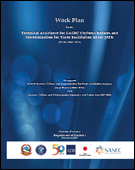 Work Plan for the Technical Assistance for SASEC Customs Reform and Modernization for Trade Facilitation under JFPRThis work plan serves as a roadmap to implement the second tranche policy actions of the SASEC Customs Reform and Modernization for Trade Facilitation Program, a policy-based loan signed between the Government of Nepal and the Asian Development Bank. Ten policy actions feature reform milestones in (i) policy and legal framework, (ii) automation, (iii) organization restructuring, and (iv) capacity development—building blocks to transform the Nepal Department of Customs into risk-based, paperless e-Customs operations, introduce customs procedures with economic impact to promote exports, and comply with WTO TFA measures and implement RKC general standards and other relevant international standards. This work plan comprises tasks designed to boost the capacity of the Customs and support delivery of its Customs Reform and Modernization Strategies and Action Plan 2017–2021. It also includes implementation arrangements, timeline, and inputs from the technical assistance (TA) attached to the Program. Author: Nepal Ministry of Finance, Department of Customs Year: 2017 Download Tags: SASEC, Customs, ADB, Nepal, Trade Facilitation Agreement Key Indicators for Asia and the Pacific 2017This report gives the latest statistics on economic, financial, environmental, and Sustainable Development Goal (SDG) indicators for the 48 regional members of the Asian Development Bank, including up-to-date figures on energy, trade, and transport. In 2016, Asia and the Pacific accounted for 40.9% of global gross domestic product (GDP). While foreign direct investment (FDI) flows declined in East Asia and Southeast Asia in 2016, FDI flows to South Asia remained stable. The average number of days required to start a business in South Asia was 16. Energy consumption is also expected to increase in the coming decades owing to increasing GDP per capita and an increase in the use of energy-consuming goods. Author: Asian Development Bank Year: 2017 Download Tags: ADB, Energy, Transport, Bangladesh, Bhutan, India, Maldives, Nepal, Southeast Asia, Sri Lanka Nepal Energy Sector Assessment, Strategy, and Road MapTo improve energy security and stimulate economic growth in the face of an unprecedented energy crisis, Nepal is accelerating the development of its hydropower sector. This report examines the performance of Nepal’s energy sector amid development constraints, and highlights government development plans and strategy. It assesses the Asian Development Bank’s (ADB’s) future support strategy, which sees Nepal’s energy sector as a key driver of inclusive economic growth. Author: Asian Development Bank Year: 2017 Download Tags: Energy, Nepal, SASEC, ADB, Hydropower 100% Electricity Generation through Renewable Energy by 2050: Assessment of Sri Lanka's Power SectorIn 2014, Sri Lanka met its target of generating at least 10% of renewable energy (RE) in its electricity mix in. The following year, the share of large hydro and RE further increased, while the country’s use of fossil fuels in the electricity mix decreased. This report aims to help design mechanisms that would allow Sri Lanka to reach its goal of 100% RE in electricity generation by 2050. It looks at financial interventions needed for Sri Lanka to achieve its goal while examining technical and economic challenges the country will face in reaching its goal. This report is a co-publication of the Asian Development Bank and the United Nations Development Programme. Author: Manpreet Singh et al Year: 2017 Download Tags: ADB, Cooperation, Hydropower, Sri Lanka, Renewable Energy, Trade Asian Development Outlook (ADO) Supplement: A Firmer Growth Outlook for AsiaGrowth forecast for developing Asia for 2018 is downgraded to 5.8%, from projections in the Asian Development Outlook 2017 Update in September 2017. Forecasts for the region’s inflation rates have been retained at 2.9% for 2018. For South Asia, growth outlook for 2018 is retained at 7.0%. India’s gross domestic product (GDP) growth rebounded to 6.3% in FY2017 (ending 31 March 2018), led by manufacturing. Bangladesh showed higher GDP growth for FY2017 (ended 30 June 2017) than was previously estimated. Bhutan showed stronger growth than forecast, supported by transport and communication services and construction. Growth projections for Maldives, Nepal, and Sri Lanka are in line with those in the Update. Author: Asian Development Bank Year: 2017 Download Tags: ADB, India, Bangladesh, Bhutan, Maldives, Nepal, Sri Lanka, Manufacturing Asian Development Bank and India: Fact SheetUpdated yearly, the Asian Development Bank (ADB) Fact Sheet provides social and economic indicators on India, as well as information on ADB operations and contact details. Millions of people from India have benefited from improvements to basic infrastructure and services from ADB-supported development programs. ADB has approved 205 loans totaling $35.1 billion for India, and will continue to support India through the pillars of inclusive growth, environmentally sustainable growth, and regional cooperation and integration. Author: Asian Development Bank Year: 2017 Download Tags: ADB, India, Infrastructure, Regional Cooperation, Sustainability Asian Development Bank and Sri Lanka: Fact SheetThis Asian Development Bank (ADB) Fact Sheet provides social and economic indicators on Sri Lanka and information on ADB operations in Sri Lanka and contact details. ADB has worked closely with the Government of Sri Lanka since 1966 and has provided loans, grants, and technical assistance totaling $8.4 billion. ADB assistance will focus on ensuring quality economic growth as Sri Lanka aims to reach upper-middle-income status. Author: Asian Development Bank Year: 2017 Download Tags: ADB, Sri Lanka, Development Asian Development Bank and Nepal: Fact SheetThe ADB Fact Sheet provides social and economic indicators on Nepal, as well as information on ADB operations in the country and contact details. Nepal is working toward graduation to middle-income country status and achieving the Sustainable Development Goals by 2030. ADB assistance aims to improve equitable access to education while pursuing a strategy that aims to address bottlenecks in infrastructure development in energy, transport, and urban facilities. ADB operations will also focus on agriculture, gender equality, good governance, environmental sustainability, regional cooperation, and private sector development. Author: Asian Development Bank Year: 2017 Download Tags: ADB, Nepal, Sustainable Development Goals, Infrastructure, Energy, Transport, Agriculture, Regional Cooperation, Gender Asian Development Bank and Bhutan: Fact SheetThe Asian Development Bank (ADB) Fact Sheet provides social and economic indicators on Bhutan, as well as information on ADB operations and contact details. Since 1982, ADB has supported Bhutan through projects in energy, finance, and trade facilitation, and transport. ADB has approved loans totaling $498.81 million, grants of $222.4 million, and $73.48 million in technical assistance for Bhutan. ADB support reflects strong emphasis on green energy production, transport connectivity, and urban infrastructure projects. To make growth more inclusive, ADB will help Bhutan through projects focusing on cross-border connectivity, skills development, and agriculture. Author: Asian Development Bank Year: 2017 Download Tags: ADB, Bhutan, Energy, Connectivity, Transport, Agriculture, Roads Asian Development Bank and Myanmar: Fact SheetUpdated yearly, this Asian Development Bank (ADB) Fact Sheet provides social and economic indicators on Myanmar, as well as information on ADB operations in the country and contact details. ADB is supporting Myanmar in promoting inclusive and sustainable economic growth, with investments focusing on infrastructure (in energy, transport, and urban and water services), education, and rural development. Regional cooperation will remain one of the key priorities. Author: Asian Development Bank Year: 2017 Download Tags: ADB, Myanmar, Sustainability, Infrastructure, Energy, Transport, Regional Cooperation Asian Development Bank and the Maldives: Fact SheetThis Asian Development Bank (ADB) Fact Sheet provides social and economic indicators on Maldives, and information on ADB operations and contact details. ADB is helping Maldives upgrade commercial and domestic harbors, ensure power supply reliability, boost economic growth, and reduce regional disparities in living standards. Projects in sustainable energy development are helping Maldives achieve carbon neutrality and reduce high fuel costs. Since 1978, ADB has approved 29 loans and grants totaling $248.53 million for Maldives, and has funded 67 technical assistance projects totaling $29.65 million. Author: Asian Development Bank Year: 2017 Download Tags: ADB, Maldives, Energy, Transport, Development, Sustainability The Internet of Things in the Power Sector: Opportunities in Asia and the PacificAsia’s power sector struggles to upgrade power systems and keep up with growing demand. The Internet of Things (IoT) has the potential to transform the power sector by optimizing operations and lowering costs for consumers. The power sector is already reaping the benefits of adoption of smart meters and smart thermostats, two consumer-oriented IoT applications. The Asian Development Bank has committed to smart grid projects in India, through a Green Energy Corridor and Grid Strengthening Project, and Maldives, through the Preparing Outer Islands for Sustainable Energy Development (Phase 1). Author: Arun Ramamurthy and Pramod Jain Year: 2017 Download Tags: Energy, ADB, India, Maldives, Sustainability Aid for Trade in Asia and the Pacific: Promoting Connectivity for Inclusive DevelopmentAid for Trade (AfT) is essential to promoting growth and tradability of services, and is a major catalyst for inclusive economic and structural information. This report looks at how trade performance in Asia and the Pacific is evolving, and highlights emerging trends in AfT. The report looks at cooperation projects in the energy sector, and shows how South Asia Subregional Economic Cooperation (SASEC) projects fund cross-border electricity transmission, power trade, energy efficiency, capacity building, and renewable sources of energy. The report also examines the impact of AfT on trade in services and the rise of e-commerce. Author: Asian Development Bank Year: 2017 Download Tags: Trade, Energy, SASEC, Aid for Trade, ADB 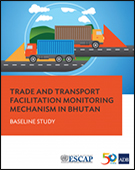 Trade and Transport Facilitation Monitoring Mechanism: Baseline Study in BhutanThis report synthesizes the business process analysis conducted on import of light motor vehicles from third countries to Bhutan via Kolkata Port, import of plastic kitchenware and tableware (melamine products) from Bangladesh to Bhutan, export of ferrosilicon from Bhutan to third countries through Kolkata Port, and export of cardamom from Bhutan to Bangladesh. It also measures the performance of trade corridors and border crossings in Bhutan, to quantify current trade and transport facilitation and provide recommendations. Findings of the study reveal bottlenecks to trade, including numerous procedures needed to complete import/export, and low speed along the trade corridors. The report includes specific short-term and long-term policies to improve Bhutan’s trade and transport facilitation. Author: Asian Development Bank and United Nations Economic and Social Commission for Asia and the Pacific Year: 2017 Download Tags: Bhutan, Trade Facilitation, Bangladesh, ADB, Transport, ADB RCI 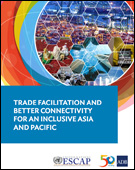 Trade Facilitation and Better Connectivity for an Inclusive Asia and PacificThis report investigates the evolution of trade costs, examines trade facilitation and paperless trade implementation, and highlights key initiatives in South Asia, including efforts by members of the South Asia Subregional Economic Cooperation (SASEC). The SASEC Trade Facilitation and Transport Working Group agreed to expand assistance to trade facilitation through technical assistance to support more efficient, transparent, secure, and service-oriented processing of cross-border trade across South Asia. Through 2025, the SASEC connectivity agenda will be better aligned with the frameworks of South Asian Association for Regional Cooperation and the Bengal Initiative for Multi-Sectoral Technical and Economic Cooperation. To help establish a trade and transport facilitation monitoring mechanism, Bangladesh, Bhutan, and Nepal conducted studies that reviewed trade and transport procedures, analyzed bottlenecks, and gave recommendations on trade and transport facilitation. Author: Asian Development Bank and United Nations Economic and Social Commission for Asia and the Pacific Year: 2017 Download Tags: ADB, Bangladesh, Bhutan, BIMSTEC, Maldives, Nepal, SAARC, India, Myanmar, SASEC, South Asia, Sri Lanka, Trade Facilitation, Transport, UNESCAP, ADB RCI 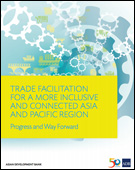 Trade Facilitation for a More Inclusive and Connected Asia and Pacific Region: Progress and Way ForwardThis report gives an overview of assessments from the 2017 global survey on trade facilitation and paperless trade in Asia and the Pacific. It looks at the implementation of trade facilitation and paperless trade measures in 44 countries in Asia and the Pacific, including how the South Asia Subregional Economic Cooperation Trade Facilitation Strategic Framework promotes development by deepening regional cooperation. The Framework covers national and subregional projects in Customs harmonization, improving cross-border facilities, and transport facilitation. The Framework also supports regulatory reforms and the development of the National Single Window Customs management system in Bangladesh, Bhutan, Maldives, and Nepal. Author: Asian Development Bank and United Nations Economic and Social Commission for Asia and the Pacific Year: 2017 Download Tags: ADB, Bangladesh, Bhutan, BIMSTEC, Maldives, Nepal, Regional Cooperation, Regional Integration, SAARC, SASEC, Standards Harmonization, Trade Facilitation, Trade Facilitation Agreement, WTO, UNESCAP, ADB RCI Myanmar’s Engagement in Regional Integration: Status and Way Forward (AWP No. 169)Myanmar strategic position connects Asia’s three big markets—Association of Southeast Asian Nations, China, and India. Since 2011, Myanmar has laid down economic reforms that are unlocking the country’s potential. This working paper discusses Myanmar’s participation in regional partnerships, such as the South Asia Subregional Economic Cooperation, which it joined in 2017. It argues that such partnerships are essential in building Myanmar’s infrastructure and speeding up its growth. Author: Prabir De Year: 2017 Download Tags: ADB, ASEAN, India, Myanmar, Regional Cooperation, Regional Integration, SASEC, UNESCAP Together We Deliver: 50 Stories of ADB's Partnerships in Asia and the PacificThis special edition of Together We Deliver tells 50 stories that highlight the importance of good partnerships in Asia and the Pacific in meeting complex development challenges. In South Asia, ADB has supported infrastructure development and social programs, helping lift people out of poverty in a diverse, rapidly urbanizing subregion. The South Asia Subregional Economic Cooperation Roads Improvement Project, for instance, is set to widen 160 kilometers of Nepal’s East–West Highway, which connects Nepal to India. The improved roads will provide faster and better access to social services and economic opportunities, and will facilitate national and regional integration. Author: Asian Development Bank Year: 2017 Download Tags: ADB, Economic Corridor Development, India, Nepal, Regional Integration, Roads, SASEC, South Asia, Transport Asian Development Bank and Bangladesh: Fact SheetThis Asian Development Bank (ADB) Fact Sheet provides social and economic indicators on Bangladesh, as well as concise information on ADB's operations in Bangladesh and contact information. ADB supports Bangladesh’s efforts to generate inclusive and sustainable growth, and achieve the Sustainable Development Goals. ADB has provided Bangladesh with $18.3 billion for 269 loans, $252.4 million for 422 technical assistance projects, and $787.10 million for 35 grants. ADB supports projects contributing to regional connectivity to foster development along economic corridors and co-finances the SASEC Railway Connectivity: Akhaura-Laksam Double Track Project. Author: Asian Development Bank Year: 2017 Download Tags: ADB, Bangladesh, Economic Cooperation, Energy, Sustainable Development Goals, Sustainability, SASEC 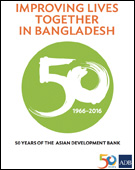 Improving Lives Together in Bangladesh: 50 Years of the Asian Development BankThis report highlights the milestones in the Bangladesh-Asian Development Bank (ADB) partnership since 1973, including projects in transport and energy that have shown sustained development results. Development contributions from ADB-assisted projects in Bangladesh include the Second South Asia Subregional Economic Cooperation Program (SASEC) Bangladesh-India Electrical Grid Interconnection Project that will help double electricity imports from India from the current 500 megawatts; the $505 million SASEC Railway Connectivity, Akhaura Laksam Double-Track Project, which will help railways meet passenger and freight demand; the SASEC Road Connectivity Project, which is upgrading a 70 km stretch along a corridor connecting the northwest to Dhaka to support domestic and subregional trade; and the SASEC Trade Facilitation Program, which aims to reduce non-tariff barriers by adopting international Customs administration protocols, upgrade existing Customs management systems, and establish a web-based electronic trade portal. Author: Asian Development Bank Year: 2017 Download Tags: SASEC, ADB, Bangladesh, India, Railway, Energy, Transport Asian Development Outlook (ADO) 2017 Supplement: Cautious Optimism for Asia's OutlookWith export demand stronger than expected in the first quarter of 2017, Asia’s GDP is expected to expand faster than forecast in April in Asian Development Outlook 2017. Developing Asia is now expected to grow by 5.9% in 2017. The smaller upgrade in the 2018 growth forecast—5.7% in ADO 2017 to 5.8%—reflects a cautious view on the pace of the turnaround in external demand. Excluding the newly industrialized economies, growth projections for the region are revised up to 6.4% for 2017 and to 6.3% for 2018. India is expected to achieve April forecasts of 7.4% growth in 2017 and 7.6% in 2018, primarily from strong consumption. Growth projections for South Asia are likewise maintained as prospects remain robust. Author: Asian Development Bank Year: 2017 Download Tags: ADB, Development, Export, Bangladesh, India, South Asia Lessons from ADB Transport Projects: Moving Goods, Connecting People, and Disseminating KnowledgeThis publication shares 20 case stories from the Asian Development Bank bearing practical lessons for transport projects across Asia and the Pacific region under different socioeconomic and political situations. The book includes reports on improving aviation in Bhutan, working on computerized transport and trade logistics in Nepal, and constructing Sri Lanka's Greenfield Highway, and the role policy plays in those projects. It also draws lessons from how India's road development increased rural communities' access to public services and economic opportunities, and how participatory processes in selecting road improvement projects in Bangladesh provide a model for long-term plan for road maintenance. Author: Asian Development Bank Year: 2017 Download Tags: ADB, Bangladesh, Bhutan, India, Nepal, Railway, Sri Lanka, Transport, ADB RCI Digital Trade Facilitation: Paperless Trade in Regional Trade AgreementsMost regional trade agreements now feature one or more measures for electronically exchanging trade-related information. These measures are becoming essential to maintaining trade competitiveness and enabling effective participation in cross-border e-commerce. This paper examines the extent to which measures enabling paperless trade are included in regional trade agreements (RTAs), such as the Association of Southeast Asian Nations-India Free Trade Agreement. India leads the region with the highest number of RTAs involving paperless trade measures. Asia-Pacific RTAs now increasingly cover specific areas of paperless trade such as electronic certificates of origin and sanitary and phytosanitary certificates. Author: Yann Duval and Kong Mengjing Year: 2017 Download Tags: ADB, ASEAN, Free Trade Agreements, India, Regional Cooperation, Trade Facilitation, UNESCAP, WTO Eradicating Poverty and Promoting Prosperity in a Changing Asia-PacificThis report explores five long-term trends in the Asia-Pacific region that will shape approaches to poverty alleviation and the prospects for achieving prosperity: regional economic cooperation and integration; rural–urban transitions; demographic changes; ICT access and connectivity; and demand for natural resources. It examines the changing development context in South Asian and other economies. It also looks at opportunities created by regional cooperation and integration that intend to bring about shared economic benefits. Author: United Nations Economic and Social Commission for Asia and the Pacific, Asian Development Bank, United Nations Development Programme Year: 2017 Download Tags: ADB, Connectivity, ICT, Regional Cooperation, Sustainability, UNESCAP, UNDP, Bangladesh, Bhutan, India, Maldives, Nepal, Sri Lanka Can Online Markets Make Trade More Inclusive? Technology-driven online trade reduces income inequality and makes trade more inclusive. To fully realize these new gains from trade, governments and export promotion agencies should address barriers to e-commerce. Technology made available by online markets has significantly reduced the cost of entry into international markets for small and medium-sized firms, which can now reach more distant consumers and create a global reputation as a seller at very low costs. Online firms, even those smaller than traditional offline firms, export, and this paper shows that online markets help reduce income inequality by providing smaller firms access to international markets. Author: Andreas Lendle and Marcelo Olarreaga Year: 2017 Download Tags: ADB, ICT, India, Trade 2016 Development Effectiveness ReviewThe Development Effectiveness Review tracks development progress in Asia and the Pacific and monitors the Asian Development Bank’s (ADB) effectiveness 2010-2016. For South Asia, ADB shares results in regional cooperation, energy, and road and rail transport. ADB also approved $4.4 billion in financing for projects in South Asia during 2016. The Review includes details of ongoing and newly approved projects. Author: Asian Development Bank Year: 2017 Download Tags: ADB, Asia-Pacific, Development, Poverty Reduction, Regional Cooperation, Regional Integration, Roads, Transport, Bangladesh, Bhutan, India, Maldives, Nepal, Sri Lanka ADB Annual Report 2016The Asian Development Bank (ADB) 2016 Annual Report provides a complete picture of ADB’s performance in the reporting year. In 2016, South Asia sustained its rapid economic growth, expanding by 6.6% despite global headwinds. ADB approved $4.4 billion in loans and grants covering 30 projects in South Asia. ADB also supported the development of the South Asia Subregional Economic Cooperation (SASEC) Vision, which articulates the region’s potential as an integrated entity. SASEC countries adopted the partnership’s first comprehensive and long-term Operational Plan covering 2016-2025, defining strategic objectives and operational priorities. The Operational Plan identifies over 200 potential projects requiring more than $120 billion in development assistance over the next five years. Author: Asian Development Bank Year: 2017 Download Tags: ADB, SASEC, South Asia 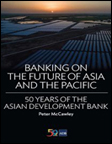 Banking on the Future of Asia and the Pacific: 50 Years of the Asian Development BankThis book tells the five-decade history of the Asian Development Bank (ADB), illustrating how the multilateral bank has grown and expanded, tackling Asia and the Pacific region’s economic development, and the evolution of its international development agenda. It discusses how ADB has helped promote regional cooperation and integration by developing subregional cooperation programs, including SASEC, which was formally established in 2001 as a project-based initiative to promote economic cooperation through the enhancement of cross-border connectivity and facilitation of trade. In 2006, the ADB Board approved the Regional Cooperation and Integration (RCI) Strategy based on four pillars: subregional economic cooperation on cross-border infrastructure and related software, trade and investment cooperation and integration, monetary and financial cooperation and integration, and cooperation in regional public goods. The RCI strategy envisaged ADB as a money bank, as a knowledge bank, as a capacity builder, and as an honest broker. Author: Peter McCawley Year: 2017 Download Tags: ADB, Development, Regional Cooperation, SASEC Asian Development Outlook 2017: Transcending the Middle-Income Challenge The Asian Development Outlook 2017 forecasts 5.7% growth for developing Asia in 2017 and 2018, and 7% and 7.2% for South Asia in 2017 and 2018. Resumption of growth in South Asia follows the brief slowdown in 2016 due to decline in fixed investment and impact of demonitization on trade and commerce. Growth in India is forecast at 7.4% in fiscal 2017 and 7.6% in 2018. In Bhutan, growth is expected to accelerate to 8.2% in 2017, with expanded investment in hydropower for export, and added capacity in electricity generation. Nepal's growth is expected to revive to 5.6% in 2017 with increased post-earthquake reconstruction and more reliable electricity. Author: Asian Development Bank Year: 2017 Download Tags: ADB, India, Bhutan, Nepal, South Asia Trade and the Post-2015 Development AgendaTrade and services are instrumental in achieving the Sustainable Development Goals. While openness to trade improves economic growth prospects, sound trade policy and efforts to reduce the costs of trade are necessary to bridge the link between trade growth and poverty reduction. For low income countries, there is still great scope to leverage trade for development, and pursue better access to a products and services to improve welfare, which can significantly contribute to economic development. In keeping with the post-2015 development agenda, this paper recommends sustained efforts by governments to reduce trade costs, support policy reforms to improve services trade, and focus on trade cost reduction and services trade facilitation. Author: Bernard Hoekman Year: 2017 Download Tags: Trade Facilitation, Services, Sustainable Development, Poverty Reduction, ADB 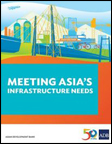 Meeting Asia's Infrastructure NeedsThis report estimates infrastructure investment needs in Asia and the Pacific for 2016-2030, updating the Asian Development Bank's assessment for 2010-2020 published in 2009. The report places developing Asia's investment needs at $26 trillion to maintain its growth momentum, eradicate poverty, and respond to climate change. While developing Asia's infrastructure, including its transport network and electricity generation capacity, has improved significantly over the years, it remains far from adequate – lack of reliable power supply continues to constrain economic growth and traffic congestion results in lost productivity, wasted fuel, and human stress. The report recommends $14.7 trillion investment for power and $8.4 trillion for transport. South Asia requires investments valued at 8.8% of gross domestic product. Author: Asian Development Bank Year: 2017 Download Tags: Asia, South Asia, Energy, Transport, Bangladesh, Bhutan, ADB, India, Maldives, Myanmar, Sri Lanka, Nepal 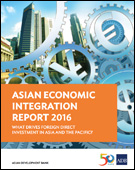 Asian Economic Integration Report 2016: What Drives Foreign Direct Investment in Asia and the Pacific?The 2016 Asian Economic Integration Report reviews regional economic cooperation and integration in Asia and the Pacific, amidst the rising global uncertainty following the United Kingdom’s referendum on leaving the European Union and the U.S. election, slower-than-expected global economic recovery, and ongoing economic restructuring in the People’s Republic of China and growth moderation. Asia faces heightened uncertainty–trade growth decelerated in 2015, falling to 2.3% in 2015; subregional trade linkages continue to strengthen, but inter-subregional trade linkages weakened; and non-tariff measures have become major obstacles to trade. In South Asia, SASEC cooperation has improved access to key markets in smaller economies, reduced real trade costs and behind-the-border barriers to stimulate investment; and enabled cross-border power exchanges to ensure power supply affordability, reliability, and overall grid stability. However, the SASEC agenda needs to be framed within wider integration processes taking place in Asia in the next decade to enhance economic linkages, and harness the full potential of Asian integration. Author: Asian Development Bank Year: 2016 Download Tags: ADB, ASEAN, Asia-Pacific, Development, FDI, Free Trade Agreements, Regional Cooperation, Regional Integration, SASEC, Trade Facilitation, UNCTAD, Bangladesh, Bhutan, India, Maldives, Nepal, Sri Lanka Improving Energy Efficiency in South AsiaThis paper examines areas where the efficiency of South Asian power systems could be significantly increased, such as the operation of thermal power plants and transmission systems. It also looks at ways to increase conservation by users through time-of-use electricity tariffs, appliance standards, and demand control through smart metering. It concludes that South Asia has a significant potential for energy efficiency improvement in the power sector, which can be realized by implementing policies and programs that can readily complement the existing institutional framework. Author: Priyantha Wijayatunga and Tilak Siyambalapitiya Year: 2016 Download Tags: Energy, ADB, South Asia, ADB RCI Disaster Risk Financing in BangladeshBangladesh is disaster-prone, with frequent severe floods and cyclones. Applying appropriate disaster risk financing is key to minimizing economic impacts from disasters, and sustaining the country’s development. This paper analyzes economic losses in Bangladesh caused by natural disasters from 2000 to 2013 and the funding gap, due in part to insufficient financial preparedness in disaster risk management. Author: Mayumi Ozaki Year: 2016 Download Tags: ADB, Bangladesh, South Asia SARSO News: Vol. 2 No. 3The South Asian Regional Standards Organization (SARSO) newsletter features updates on SARSO events and activities. This issue highlights SARSO efforts to strengthen international relations, through its participation in the 39th International Organization for Standardization (ISO) meeting in Beijing, China, and related activities. The issue also features a meeting with the Asian Development Bank (ADB), where ADB briefed SARSO on the progress of diagnostic studies in South Asia Subregional Economic Cooperation (SASEC) member countries. Author: South Asian Regional Standards Organization Year: 2016 Download Tags: SARSO, ADB, SASEC 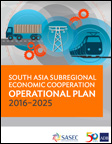 South Asia Subregional Economic Cooperation Operational Plan 2016-2025The SASEC Operational Plan 2016–2025 embodies the strategic objectives and operational priorities of the SASEC Program for the next decade. It expands the SASEC Program's focus beyond intraregional cooperation to developing links with Southeast and East Asia, thus widening the scope of transport, trade facilitation, and energy cooperation. Economic and industrial corridor development, which will arise from improved connectivity, has been introduced as a priority initiative. SASEC 2025 is supported by a list of potential projects to be implemented in the subregion during 2016-2025, that will advance the SASEC goals of multi-modal connectivity, energy security and the growth of regional energy markets, and increased intra- and inter-regional trade. An
update to the operational plan was
published in 2020. Author: Asian Development Bank Year: 2016 Download Tags: SASEC, ADB, Trade Facilitation, Economic Corridor, Transport, Myanmar 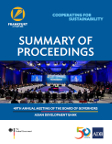 Summary of Proceedings of the 49th Annual Meeting of the Board of GovernorsThis publication provides a summary of the proceedings of the 49th Annual Meeting of the Asian Development Bank (ADB) Board of Governors, held in Frankfurt, Germany from 2-5 May 2016. It also includes statements from the Governors of ADB member countries, including SASEC countries. In his address, Mr. Abul Maal Muhith, Governor, Bangladesh, called for further acceleration of ADB's regional cooperation and integration strategy, which could play a critical role in accelerating economic growth, reducing poverty and economic disparity, and raising productivity and employment and environmental sustainability in Bangladesh, and lauded ADB's support in the signing of the landmark Bangladesh-Bhutan-India-Nepal Motor Vehicle Agreement (BBIN MVA). Mr. Arun Jaitley, Governor, India, highlighted India's strong and renewed commitment to regional cooperation in South Asia, which was demonstrated with the signing of the BBIN MVA and ongoing negotiations for the India-Myanmar-Thailand Highway. He also emphasized partnership between ADB and India in the development of the East Coast Economic Corridor, with initial focus on the ‘Vizag Chennai Industrial Corridor’, which will play a major role in connecting India to global production networks and value chains in the ASEAN region. Author: Asian Development Bank Year: 2016 Download Tags: ADB, Bangladesh, India, Regional Cooperation, Poverty Reduction Asian Development Outlook 2016 Supplement: Asia's Growth Prospects Undimmed by Brexit VoteRecent global developments have prompted revisions to developing Asia's 2016 and 2017 growth outlook, as published in March in Asian Development Outlook 2016 (ADO 2016). Uncertainty following the British vote to leave the European Union chilled already tepid recovery in the euro area. While developments have affected developing Asia’s currency and stock markets, its impact on the real economy in the short term is expected to be small. This Supplement expects the region to expand by 5.6% in 2016 and 5.7% in 2017. India has shrugged off global headwinds and is expected to grow by 7.4% in 2016 and 7.8% next year. South Asia as a whole will be the region’s fastest growing subregion. Author: Asian Development Bank Year: 2016 Download Tags: ADB, South Asia, Development ADB 2015 Development Effectiveness ReviewThe Asian Development Bank (ADB) is committed to implementing reforms to reach its goals to be a bigger, faster, and stronger development institution. The 2015 Development Effectiveness Review is the annual performance report of the ADB. It tracks development progress in Asia and the Pacific and monitors ADB's effectiveness. The report also takes a look at rapid gains made by ADB developing member countries and examines the challenges that lie ahead. Planned reforms laid out in the book include those that tackle sustainability issues internally and in developing member countries. Author: Asian Development Bank Year: 2016 Download Tags: Development, Asia-Pacific, Poverty Reduction, ADB ADB Annual Report 2015The Asian Development Bank's (ADB) 2015 Annual Report provides a complete picture of ADB’s performance in the reporting year. In 2015, South Asia became the fastest-growing regional economy in Asia and the Pacific, and ADB's assistance to the region approached $3.80 billion in combined loans and grants for 22 projects and $37.26 million in grants for technical assistance. Through the South Asia Subregional Economic Cooperation (SASEC) Program, ADB also continued to drive tighter integration in the region, enhancing cooperation and boosting connectivity with initiatives including helping finalize the Bangladesh-Bhutan-India-Nepal and India-Myanmar-Thailand Motor Vehicle Agreements, Bangladesh-India power grid upgradation, preparation of high-priority transport projects in Bangladesh, and analytical studies for India's East Coast Economic Corridor. Author: Asian Development Bank Year: 2016 Download Tags: ADB, SASEC, BBIN, Energy, Transport Asian Development Outlook 2016: Asia’s Potential GrowthThe Asian Development Outlook 2016 forecasts 5.7% growth for developing Asia in 2016 and 2017. It projects that South Asia will post the most rapid growth in developing Asia, with growth in the subregion accelerating to 7% in 2015, and will accelerate further to 7.3% in 2017 after a slight dip to 6.9% in 2016. India's growth is expected to undergo a slight slowdown to 7.4% in 2016 as exports decline and both public and private investment slows, but rebound to 7.8% in 2017 as the business environment improves, and exports and investment recover. Bangladesh will also see continued moderate growth, resulting from sustained progress toward macroeconomic and structural reform. Author: Asian Development Bank Year: 2016 Download Tags: Asia, India, Bangladesh, Economic Growth, Development, ADB 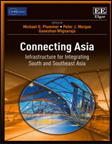 Connecting Asia: Infrastructure for Integrating South and Southeast AsiaThis book contains background papers prepared for the Asian Development Bank and the Asian Development Bank Institute joint study, 'Connecting South Asia and Southeast Asia.' It emphasizes the potential contribution to growth that greater connectivity—through better transport and energy infrastructure and improved soft infrastructure, including trade facilitation—between South Asia and Southeast Asia can foster. With benefits including greater participation in global supply chains for South Asia; lower trade costs; and increase in inter- and intraregional trade, the book underscores that, at a juncture where closer regional integration can secure sustainable and inclusive growth for economies in the two regions, specific policies should be examined and considered to enable both regions to maximize gains from greater integration. Author: Michael G. Plummer, Peter J. Morgan, Ganeshan Wignaraja, eds. Year: 2016 Download Tags: South Asia, Southeast Asia, Trade Facilitation, Transport, Energy, ADB, Economic Corridor, Bangladesh, India, Sri Lanka, ADB RCI 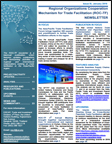 Regional Organizations Cooperation Mechanism for Trade Facilitation, Issue IX, January 2016This biannual publication features updates, publications and forthcoming activities of regional and international organizations working on trade facilitation in the Asia-Pacific region, including the Asian Development Bank (ADB), the World Customs Organization (WCO), and the United Nations Economic and Social Commission for Asia and the Pacific. It includes highlights of the Asia Pacific Trade Facilitation Forum 2015 and the Train-the-Trainer Workshops on Customs Valuation through Post Clearance Audit being jointly implemented by the WCO and ADB in the 6 SASEC member countries. This issue also features an analysis on achieving seamless supply chains through implementing comprehensive and pragmatic national trade facilitation reform programs. Author: UNESCAP Year: 2016 Download Tags: Trade Facilitation, Asia-Pacific, WCO, ADB, UNESCAP, Customs Valuation, Nepal, Bangladesh, Bhutan, India, Maldives, Sri Lanka Asian Development Outlook 2015 Supplement: Growth Holds Its Own in Developing AsiaThis Supplement maintains growth forecast for developing Asia at 5.8% in 2015 and 6.0% in 2016. In South Asia, economic outlook remains optimistic, with the region on track to meet Update projections of 6.9% in 2015 and 7.3% in 2016. India's economic expansion balances a slowdown in Bhutan—owing to weaker sales of hydropower—and the Maldives in 2015, and in Nepal in 2016—due to unfavorable weather and unforeseen delays in earthquake-related reconstruction. Growth projections for Bangladesh and Sri Lanka remain in line with those in the Asian Development Outlook Update. Author: Asian Development Bank Year: 2015 Download Tags: ADB, South Asia, Bangladesh, Bhutan, India, Maldives, Nepal, Sri Lanka A Framework of Trade Policy for Bhutan: Compatible with the Gross National HappinessThis paper examines the compatibility between Bhutan's gross national happiness (GNH) index and trade policy, and attempts to contextualize Bhutan's trade policy issues - inclusive growth, trade facilitation, incidence of tariffs, and World Trade Organization accession. It explores trade and industry policy that is compatible with GNH guidelines, which aim to measure and improve people's holistic well-being: although it also includes factors that are seemingly unfavorable to an active trade policy. The report recommends benchmarking successful development strategies in other countries and creating an organization to pursue a more active trade policy to accomplish the urgent task of raising general living standards. Author: Inkyo Cheong, Taeho Bark, and Hoe Yun Jeong Year: 2015 Download Tags: Bhutan, WTO, Trade Policy, ADB Asian Development Outlook 2015 Update: Enabling Women, Energizing AsiaThis Update revises growth forecast for the Asia and the Pacific region down to 5.8% in 2015 and 6.0% in 2016, with delayed recovery in major industrial economies and slowing investment prospects in India and the People's Republic of China. Growth acceleration in South Asia has also been more modest than forecast - now projected at 6.9% in 2015, below the 7.2% March forecast, but up from 6.7% in 2014, and forecast to rise further to 7.3% in 2016. The need to energize growth in the region calls for avenues to unlock untapped resources, including narrowing gender gaps in the labor market. In Bangladesh, the increase in women's participation in the workforce has not only enhanced their bargaining power at home, but improved health and education options for the family. Author: Asian Development Bank Year: 2015 Download Tags: Asia-Pacific, Economic Growth, ADB Cross-Border Power Trading in South Asia: A Techno Economic RationaleSouth Asian countries have a wealth of diverse energy sources. These renewable resources, along with the varying electricity demand patterns among countries in South Asia, open up opportunities to share resources through electricity trading, which can be enabled by strengthening the electricity transmission system. This study examines the cost and benefit of six cross-border electricity transmission interconnections, and measures the economic and reliability benefits for participating countries in South Asia. Author: Priyantha Wijayatunga, D. Chattopadhyay and P. N. Fernando Year: 2015 Download Tags: Energy, SAARC, Regional Trade, ADB, ADB RCI Lessons for South Asia from the Industrial Cluster Development Experience of the Republic of KoreaGrowth of manufacturing is crucial for economic growth and poverty reduction. This report highlights the industrial cluster development policy of the Republic of Korea, including its success factors in terms of policy implementation, and the promotion of industrial cluster development, drawing lessons that could enhance industrial growth in South Asia. It discusses how the government encouraged increase in exports through relevant policies and adapted to more technology- and knowledge-intensive industries which required innovation-driven policies. The experience outlined in the report could benefit large-scale industrial promotion in South Asia, such as the Economic Corridor Program in India. Author: Jong-il Kim Year: 2015 Download Tags: South Asia, Industrialization, Economic Corridor, Trade, ADB, India, Bangladesh, Sri Lanka, ADB RCI Aid for Trade in Asia and the Pacific 2015This Asian Development Bank report explores the potential of the digital economy to improve the inclusiveness of Aid for Trade (AfT). It uses the review of AfT as a springboard to explore new ways of thinking and how to address issues such as high trade costs in some regions. In particular, it considers how to build on information and communications technology and infrastructure connectivity from established AfT spending. The report also highlights the experience of exporters to illustrate the unique challenges and opportunities for trade-driven growth in a region where high trade costs are structural. Author: Alisa Di Caprio and Kati Suominen Year: 2015 Download Tags: ICT, Infrastructure, Trade, ADB, Asia-Pacific, Exports, Economic Growth, Trade Facilitation 2015 Annual Evaluation ReviewCountry assessments conducted by an independent evaluation team between CY2010-CY2014, and published in the the Asian Development Bank’s (ADB) 2015 Annual Evaluation Review, show relatively good performance of ADB operations in South Asia. Programs implemented in Bhutan and India, notably, reflected more developed institutional and organizational capacities in ADB sectors of engagement, alongside robust private sector involvement. Nepal and Sri Lanka programs, though affected by civil strife, were also rated successful. This report examines ADB operational performance in 2014, and includes evaluation recommendations. It aims to enhance ADB effectiveness by providing feedback on policies, strategies, operations, and special concerns in Asia and the Pacific. Author: Independent Evaluation Department Year: 2015 Download Tags: ADB, Evaluations, India, Bhutan Towards Trade Policy Analysis 2.0: From National Comparative Advantage to Firm-Level Trade DataThis paper argues for the need to upgrade current analytical tools for trade policy analysis and complement them with more detailed, firm-level data. Firm-level data allows a more refined assessment of future impact of trade policy initiatives, improves ex-post assessments, and enhances communication leading to a meaningful engagement with stakeholders, thus reducing public misperceptions about trade policy. A Trade Policy Analysis 2.0 could contribute to a better understanding of international trade for firm competitiveness, job creation, and consumer welfare. Author: Lucian Cernat Year: 2015 Download Tags: Trade Policy, Firms, Trade, ADB Policy Enablers for New Wind Energy MarketsThis publication focuses on the wind energy policies that can support sustained development of wind power in emerging wind energy markets. The policies are based on the work done by Quantum Leap in Wind Power Development in Asia and the Pacific (QLW). QLW is a $2 million, 3-year project funded by the Asian Development Bank, to facilitate wind power sector development in developing countries. The success and failures of wind energy policies in Mongolia, the Philippines, and Sri Lanka – including its impact and evolution – are analyzed in this report. Author: Pramod Jain and Bo An Year: 2015 Download Tags: Energy, Asia-Pacific, Sri Lanka, Sustainability, ADB Electricity Consumption, Output, and Trade in BhutanThis ADB South Asia Working Paper examines the relationship between electricity consumption, international trade, and economic growth using an augmented production function framework. The findings show that Bhutan is energy-dependent and can promote economic growth through future investment in hydropower. More specifically, the results show that a 1% increase in (i) electricity consumption generates 0.03%-0.05% increase in output, (ii) total trade results in 0.5% increase in output, (iii) trade openness results in 1% increase in output. Author: Hooi Hooi Lean and Russell Smyth Year: 2015 Download Tags: Energy, Trade, Bhutan, ADB, South Asia, Hydropower, ADB RCI Developing Economic Corridors in South Asia This book describes key conditions for transforming transport corridors into economic corridors and establishes the rationale for developing economic corridors, and the related benefits from production value chains along those corridors. It further emphasizes the significant potential of economic corridors in South Asia, particularly those being developed under the South Asia Subregional Economic Cooperation Program. The chapters highlight the impact of trade barriers on bilateral trade and present case studies on trade facilitation in South Asia. Countries in the subregion would benefit by working closely to exploit the full economic potential of economic corridors. Author: Asian Development Bank Year: 2014 Download Tags: Economic Corridor, South Asia, Trade Facilitation, Bangladesh, India, Sri Lanka, ADB, SASEC, Bilateral Trade, Transport Trans-Pacific Partnership versus Regional Comprehensive Economic Partnership: Control of Membership and Agenda Setting This ADB Working Paper argues that the formation of regional integration frameworks can be best understood as a dominant state’s attempt to create its own regional framework where it can exercise some exclusive influence. It explores the Trans-Pacific Partnership and the Regional Comprehensive Economic Partnership (RCEP). It also analyzes the strategies of key players such as ASEAN, Korea, India, Japan, USA and China. India is part of the RCEP negotiating process and sees increased presence in Southeast and East Asian markets, closer relations with ASEAN, and increased connectivity with North Asia and Oceana as benefits from involvement in RCEP. Author: Asian Development Bank Year: 2014 Download Tags: Regional Integration, India, Connectivity, ADB, Regional Cooperation, ASEAN 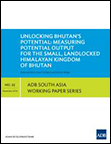 Unlocking Bhutan’s Potential: Measuring Potential Output for the Small, Landlocked Himalayan Kingdom of Bhutan The hydropower sector has driven Bhutan's economic growth in the past two decades with growth rates averaging 7.9%. Yet, the economy has not been invulnerable to market fluctuations and external shocks. This ADB South Asia Working Paper analyzes how Bhutan can create sustainable and inclusive growth, alongside the continuous expansion of its hydropower industry. It examines how certain policies can impact Bhutan's potential growth over 2013–2030. Results show that higher investment in education, health, and efforts to diversify its economic base—including enhancement of new industries with linkages to regional and global value chains—can further drive economic growth and improve the country's living standards. Author: Sabyasachi Mitra, Sarah Carrington, and Anthony Baluga Year: 2014 Download Tags: Bhutan, Energy, Economics, Hydropower, ADB, South Asia, Sustainability, Global Value Chains, Economic Growth Seaborne Trade between South Asia and Southeast Asia This Asian Development Bank Institute paper examines trade and the main ports around the Bay of Bengal to identify projects that will enable trade and contribute to improved maritime infrastructure. It also reviews the nature of trade and trade patterns, particularly through the Indian East Coast Corridor study. The paper develops further strategic options for seaport adjustment around the Bay of Bengal to support trade evolution, policy assessment, and other constraints. Author: David Wignall, Mark Wignall Year: 2014 Download Tags: Transport, Trade, Ports, ADB, India, Economic Corridor, Bangladesh, Energy, Myanmar, Sri Lanka Global Production Networks and Economic Corridors: Can They Be Drivers for South Asia’s Growth and Regional Integration?This Asian Development Bank South Asia Working Paper examines the role of regional and national economic corridors in facilitating access of South Asian countries to global production networks (GPNs), particularly East Asia and Southeast Asia. It also reviews the state of regional trade integration and examines the nature of engagement in South Asia, specifically India, with its dynamic and high growth GPNs. The paper further identifies key factors that constrain engagement of South Asian countries with East and Southeast Asia in GPN trade. Author: Kunal Sen Year: 2014 Download Tags: South Asia, Global Production Network, Economic Corridor, ADB, Regional Integration, India, Bangladesh, Sri Lanka SASEC Website BrochureThis promotional brochure for the SASEC website features the web portal as a one-stop shop for information on SASEC activities, events, projects, and knowledge materials. The SASEC website seeks to build a dynamic discussion platform and repository of data on regional cooperation. Author: Asian Development Bank Year: 2014 Download Tags: SASEC, Knowledge Product, ICT, ADB, Bangladesh, Bhutan, India, Maldives, Nepal, South Asia, Transport, Trade Facilitation, Energy SASEC BrochureThis promotional brochure is a concise introduction to the South Asia Subregional Economic Cooperation (SASEC) Program, highlighting the main areas of regional cooperation and activity. It includes facts and figures about SASEC projects in transport, trade facilitation, energy, and ICT. Author: Asian Development Bank Year: 2014 Download Tags: SASEC, Trade Facilitation, Regional Cooperation, ICT, ADB, Bangladesh, Bhutan, India, Nepal, Maldives, Sri Lanka, Energy, Transport, Connectivity, Myanmar 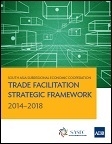 SASEC Trade Facilitation Strategic Framework 2014-2018The South Asia Subregional Economic Cooperation (SASEC) Trade Facilitation Strategic Framework 2014-2018 builds on the momentum of member countries over recent years in forging ahead with many significant improvements to facilitate, and ultimately increase, trade in the subregion and with the rest of the world. It supports the mission of the SASEC Transport and Trade Facilitation Strategy “to promote the prosperity of the subregion by facilitating the efficient movement of trade across the borders”, and focuses on five priority areas: customs modernization and harmonization; standards and conformity assessment strengthening; cross-border facilities improvement; through-transport facilitation; and institution and capacity building. Author: Asian Development Bank Year: 2014 Download Tags: SASEC, Trade Facilitation, Regional Cooperation, Transport, Trade, Customs, Standards, Harmonisation, Regional Integration, ADB, Bangladesh, Bhutan, India, Maldives, Nepal, Sri Lanka, South Asia, ADB RCI ASEAN, PRC, and India: The Great TransformationThis joint study by the Asian Development Bank and the Asian Development Bank Institute highlights the Association of Southeast Asian Nations, the People’s Republic of China, and India (collectively referred to as ACI economies) as drivers of the global economy. It explores links among ACI economies and how these may shape regional and global competition and cooperation. The study also notes that Asia’s leading economies can foster a positive outcome through a paradigm shift toward inclusive, green, and knowledge-led growth. Adoption of low-carbon, green growth strategies can help place ACI economies on a sustainable growth path. Furthermore, infrastructure and human capital investments can link ACI economies through region-wide free trade and investment agreements. Author: Asian Development Bank and Asian Development Bank Institute Year: 2014 Download Tags: India, Asia-Pacific, Regional Cooperation, ADB, ASEAN, Investment 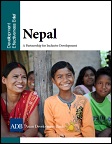 Nepal: Development Effectiveness Brief 2014Nepal has the potential to achieve more inclusive growth and can largely benefit from regional cooperation and integration with its developing neighbors. It is also benefiting from South Asia Subregional Economic Cooperation, a flagship ADB-supported program that promotes economic cooperation and integration in areas of trade facilitation (custom modernization and transport connectivity), power development, trade, and tourism development. This brief further explores ADB’s contribution to inclusive development and poverty reduction, energy, and transport. Exporting energy when surplus is available is one way of meeting seasonal demand by subregional cooperation and power trade. Transport infrastructure is also another key ingredient to equitable, inclusive growth that can address challenges such as lack of market access, inadequate roads, and poor connectivity. Author: Asian Development Bank Year: 2014 Download Tags: Nepal, Regional Cooperation, South Asia, ADB, Connectivity, Energy, Roads, SASEC, Trade, Transport Future of Factory AsiaThis volume, co-published by the Asian Development Bank and the Korea Economic Research Institute, reflects one of the broad thematic sessions of the Seoul conference, Beyond Factory Asia. It assesses the challenges and sustainability of the Factory Asia model – supplying from the East and consuming in the West – and provides suggestions and strategies on effective management of these concerns. The volume further analyzes obstacles in the success of Factory Asia, its speed in expanding its own domestic and regional markets, and its progress in upgrading competitiveness in the manufacturing sector. The new Factory Asia must nurture new sources of growth in the region and focus on regional economic integration. Author: Choi Byung-il and Changyong Rhee (eds.) Year: 2014 Download Tags: Economic Integration, Asia-Pacific, Trade Policy, ADB, Asia, Manufacturing, Regional Integration, Bangladesh, Energy, Sri Lanka, Transport 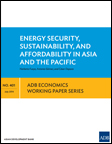 Energy Security, Sustainability, and Affordability in Asia and the PacificEnergy security, sustainability, and affordability from 2010 to 2035 for Asian Development Bank’s Asia and Pacific members are calculated in this working paper, including potential benefits of integrating energy systems regionally. Based on business-as-usual and alternative scenarios, outlook on SASEC member countries by 2035 include (i) dramatic improvement in Bhutan's energy efficiency, (ii) slight decrease in Bangladesh's energy intensity—although carbon dioxide will increase in its primary energy mix, as dependence on fossil fuels rise, and (iii) decrease in energy self-sufficiency of SASEC member countries by 2035, but improved energy affordability. Since renewable energy sources and importation of energy may be capital-intensive, requiring additional tariff support, regional cooperation can enhance affordability and energy security—with Bhutan and Nepal standing to benefit greatly from energy integration in South Asia. Author: Norberto Fueyo, Antonio Gómez, and César Dopazo Year: 2014 Download Tags: Energy, Bhutan, Nepal, Sustainability, Asia-Pacific, ADB, Regional Integration, SASEC, South Asia, Bangladesh, Sustainability, Renewables, Tariff, Regional Cooperation 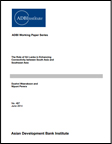 The Role of Sri Lanka in Enhancing Connectivity between South Asia and Southeast Asia As Sri Lanka rebuilds at the end of a 30-year conflict, its progress in improving physical infrastructure—including the Colombo port expansion and other programs for new expressways and road connectivity—has been significant. Yet, the country has seen a sharp decline in its overall exports-to-gross domestic product ratio. How Sri Lanka can benefit from greater connectivity with its neighbors in South Asia and Southeast Asia is discussed in this paper. Trade policies geared towards enhancing regional integration efforts could boost Sri Lanka's economy. Additionally, to lessen the challenges of financing and sustaining implementation of planned infrastructure development efforts, Sri Lanka could also implement a more stringent institutional and regulatory environment encouraging more private sector participation. Author: Dushni Weerakoon and Nipuni Perera Year: 2014 Download Tags: Trade Policy, Trade Facilitation, Sri Lanka, Connectivity, South Asia, Southeast Asia, ADB, Transport, Regional Integration Opportunity Cost of Natural Gas Subsidies in BangladeshThis paper examines the impact of optimal gas pricing policy using a general equilibrium model for the Bangladesh economy. It estimates the opportunity cost of underpricing or subsidizing gas in Bangladesh. It further explores the potential impacts of an increase in investment on social and physical infrastructure using the social accounting matrix multiplier model. The results reveal that Bangladesh is losing a significant development opportunity due to its gas subsidy. Calculations using a dynamic computable general equilibrium model suggest that withdrawal of the gas subsidy along with increased investments in physical and social infrastructure would lead to positive macroeconomic and sectoral effects in Bangladesh. Author: Herath Gunatilake and Selim Raihan Year: 2014 Download Tags: Bangladesh, Energy, ADB, Investment 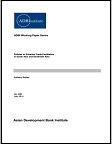 Policies to Enhance Trade Facilitation in South Asia and Southeast AsiaThis Asian Development Bank Institute publication identifies the state of play of trade facilitation and provides an overview of intra- and inter-regional trade in South and Southeast Asia. It highlights key challenges and bottlenecks to effective trade facilitation, ranging from the lack of expert human resources such as information technology specialists in small landlocked countries (Bhutan and Nepal), to the high border transaction costs and severe congestion faced at border crossing points, and the lack of effective dialogue on bilateral enhancement of trade facilitation. Regional initiatives such as the South Asia Subregional Economic Cooperation Program aim to address these challenges through customs modernization and harmonization, automation, and the use of international best practices in border procedures. Author: Anthony Bayley Year: 2014 Download Tags: South Asia, Trade Facilitation, Trade Policy, Southeast Asia, ADB, ICT, Bhutan, Nepal, SASEC, Customs Asian Development Outlook 2014: Fiscal Policy for Inclusive GrowthThe Asian Development Outlook, ADB’s flagship economic publication provides comprehensive macroeconomic analysis in Asia including growth projections by country and region. The Asian Development Outlook 2014 forecasts that developing Asia will grow 6.2% in 2014 and 6.4% in 2015. South Asia remains one of the slowest growing subregions—although growth is forecast to improve by 5.3% in 2014 and 5.8% in 2015. Author: Asian Development Bank Year: 2014 Download Tags: ADB, Bangladesh, Bhutan, Economic Corridor, Energy, India, Maldives, Nepal, Sri Lanka, Transport The ASEAN Economic Community: A Work in ProgressThis publication explores the barriers and impediments to the realization of an ASEAN Economic Community (AEC), and to what extent its self-imposed deadline of 2015 for achievement of an AEC is more of a milestone of progress than a firm target. It examines whether the AEC is achievable, the obstacles faced in achieving it, and the measures required to help it become a reality. Author: Asian Development Bank Year: 2013 Download Tags: Regional Cooperation, Regional Integration, Trade Policy, ASEAN, Economic Integration, Regional Cooperation, ADB, Regional Integration, Services, Global Value Chains, Non-Tariff Measures, Asia-Pacific Trade Agreement, India, Trade Facilitation ARIC Information Pack: October 2013The ARIC Information Pack compiles news and events on regional cooperation & integration (RCI) that corresponds to ADB's four RCI pillars: cross-border infrastructure, trade and investment, money and finance, and regional public goods. A special feature on the implications of the US recovery to Asian exports also appears in this issue. Author: Asian Development Bank Year: 2013 Download Tags: Regional Cooperation, Regional Integration, ADB, SASEC Climate Action South Asia: Information Update No. 2 (Economics of Reducing Greenhouse Gas Emissions in South Asia: Options and Costs)The study Economics of Reducing Greenhouse Gas Emissions: Options and Costs in Bangladesh, Bhutan, the Maldives, Nepal, and Sri Lanka reveals excellent opportunities in low-carbon green growth by pursuing resource- and energyefficient technologies that would lower emissions of greenhouse gases at low cost or even cost saving (benefits). Author: Asian Development Bank Year: 2013 Download Tags: Economics, Climate, Climate Change, Economics, South Asia, Bangladesh, Bhutan, Maldives, Sri Lanka, Energy, Environment, Sustainability, ADB, Nepal, Development, Hydropower Climate Action South Asia: Information Update No. 1 (Development in an Era of Accentuated Climate Risks)To steer South Asian economies toward green, low-carbon, and climate-resilient development and for these to take hold in South Asia, the countries need (i) better understanding and greater public awareness of the implications of climate change, (ii) climate risks screening and decision-support tools for identifying actions and managing results, (iii) improved governance and institutional capacities to take necessary actions to manage climate change impacts, (iv) funding sources for such actions, and (v) projects and programs demonstrating positive results that can be scaled up. Author: Asian Development Bank Year: 2012 Download Tags: Economics, Climate, Climate Change, Environment, Sustainability, South Asia, Development, Economic Growth, ADB |




